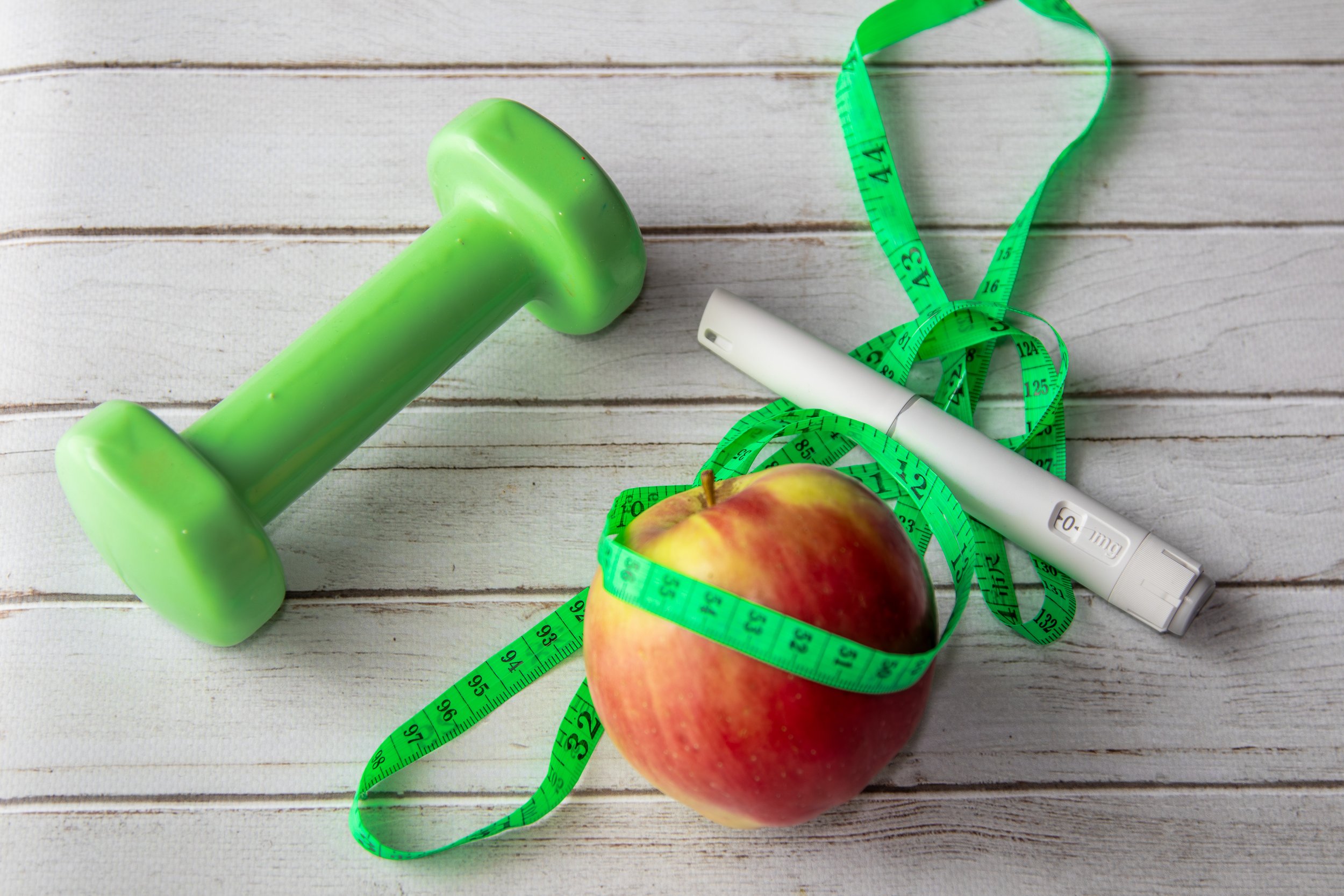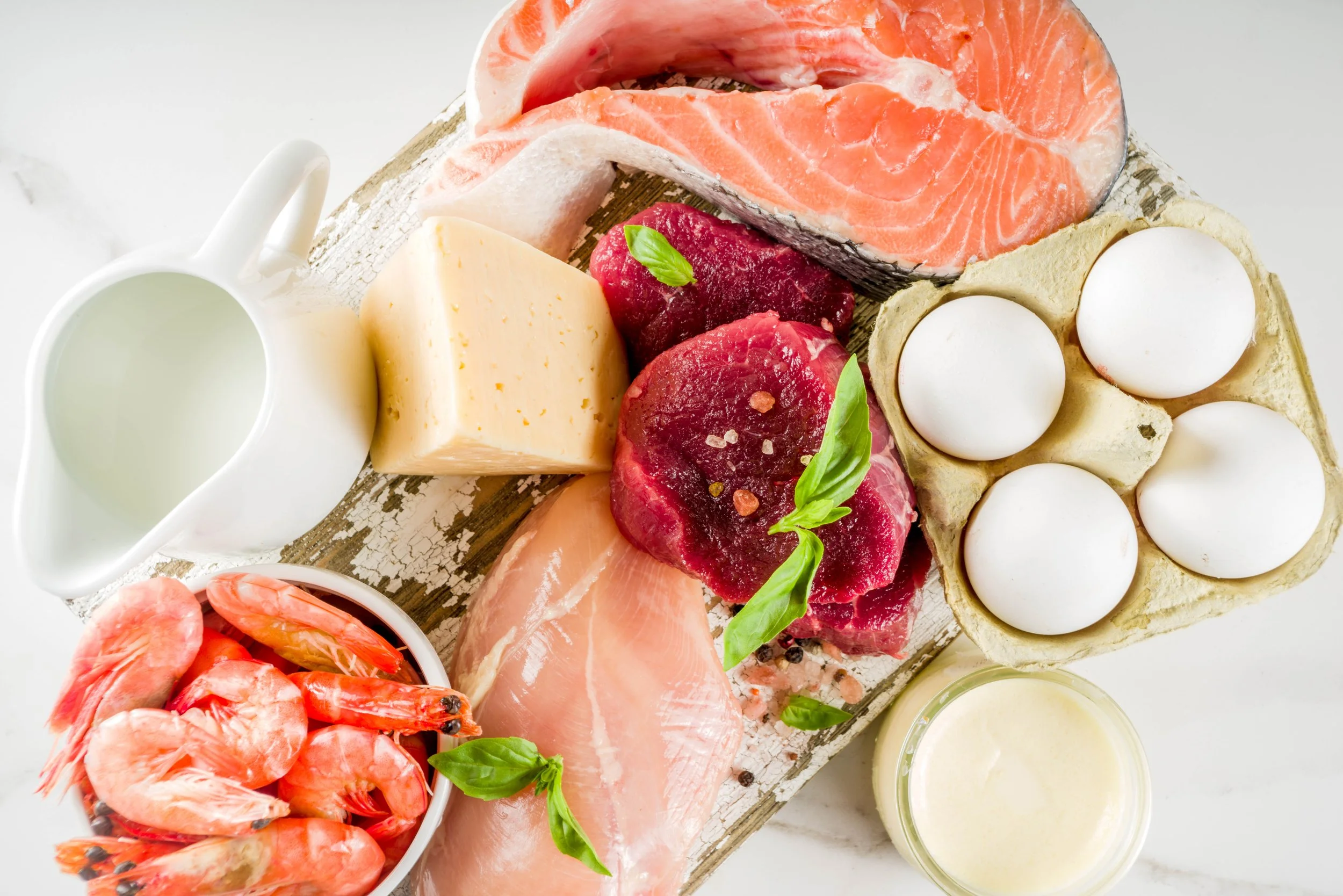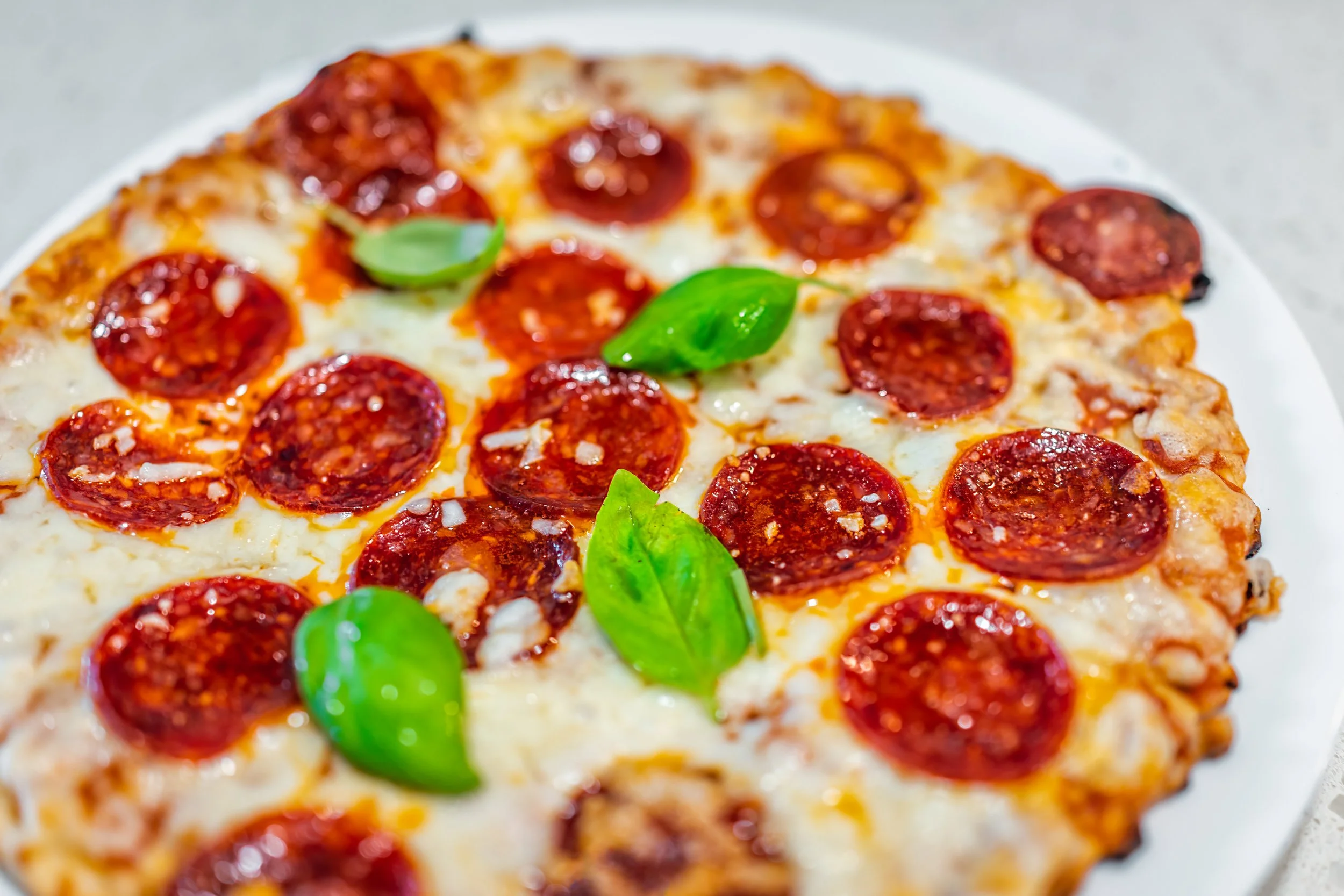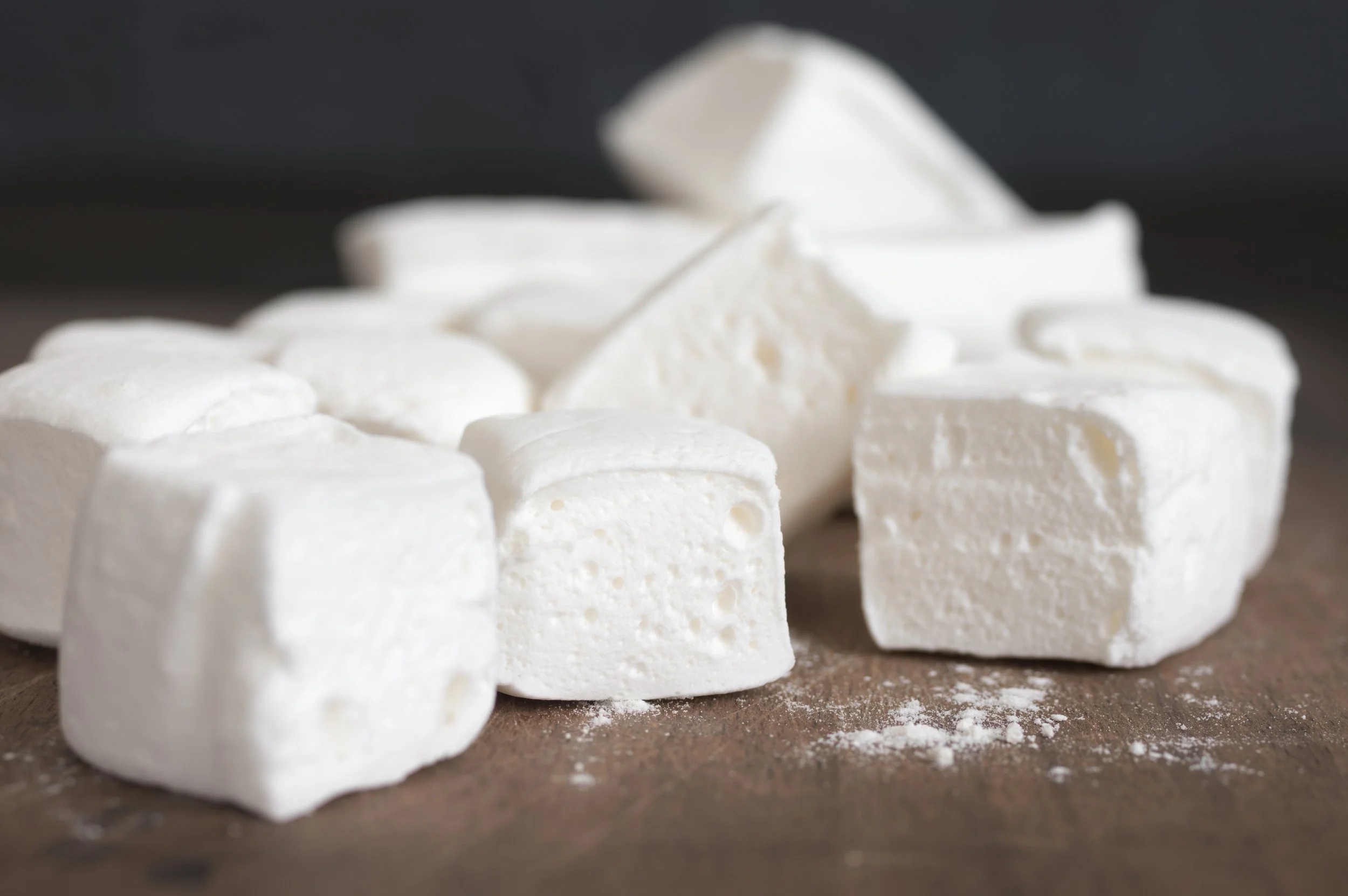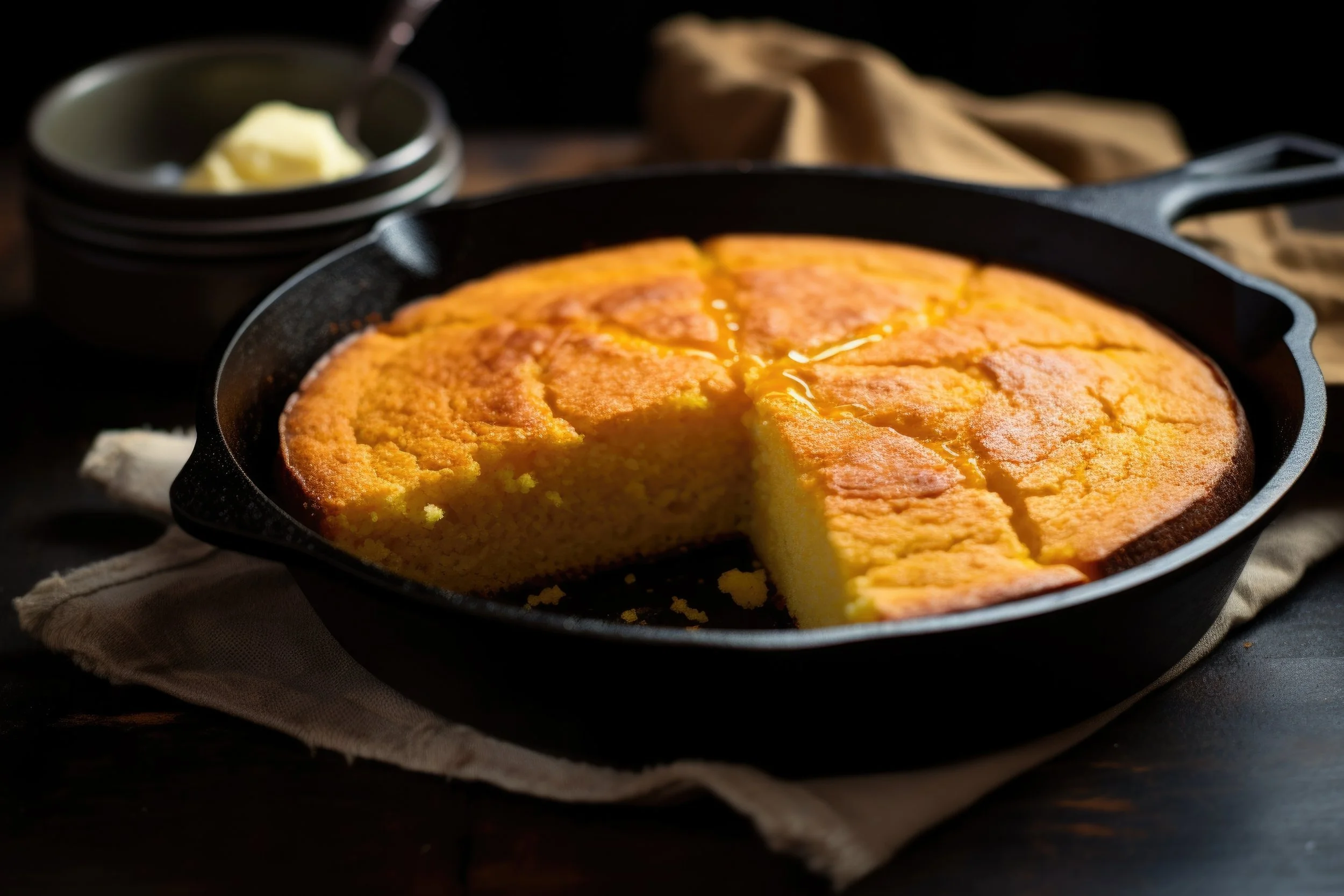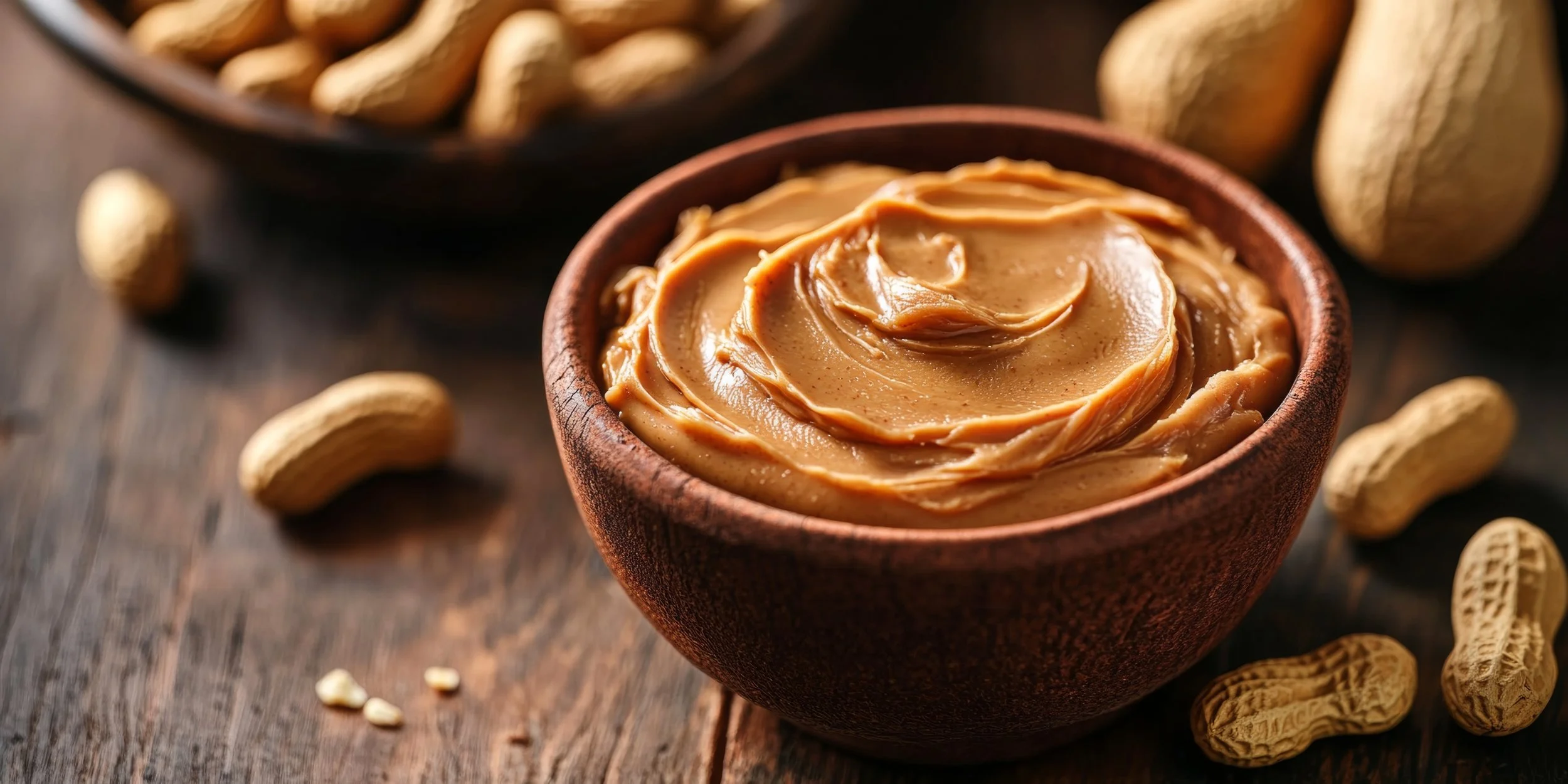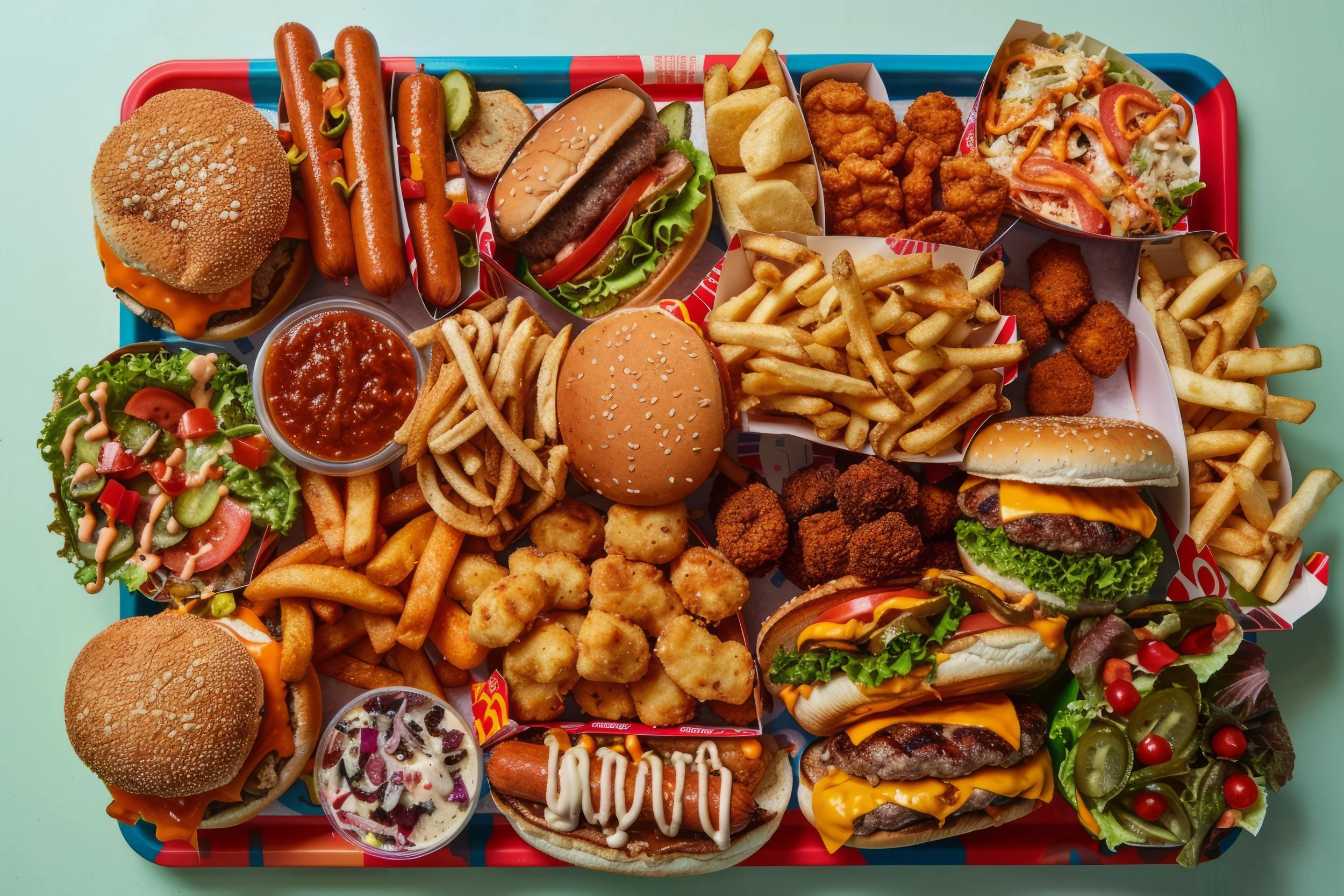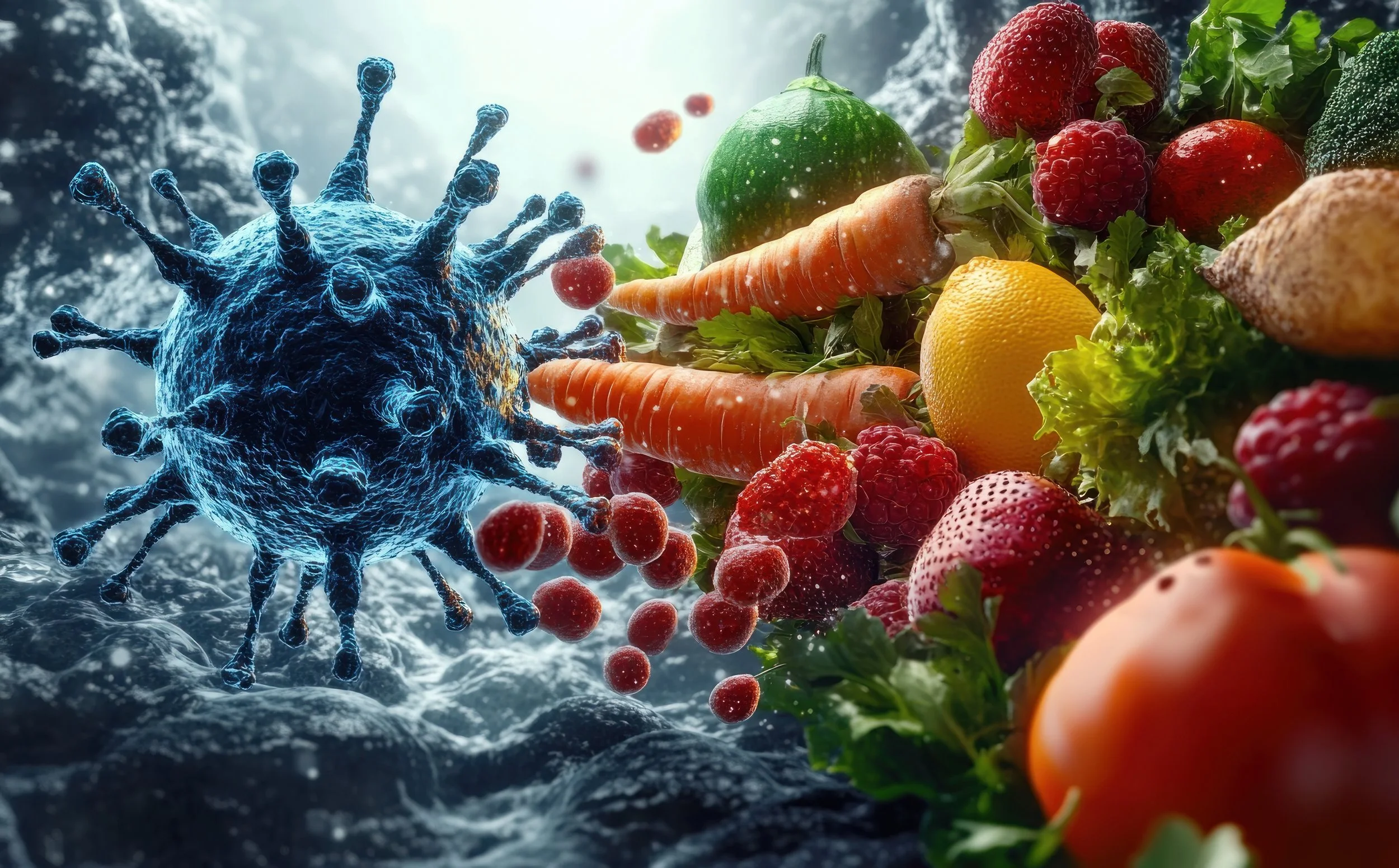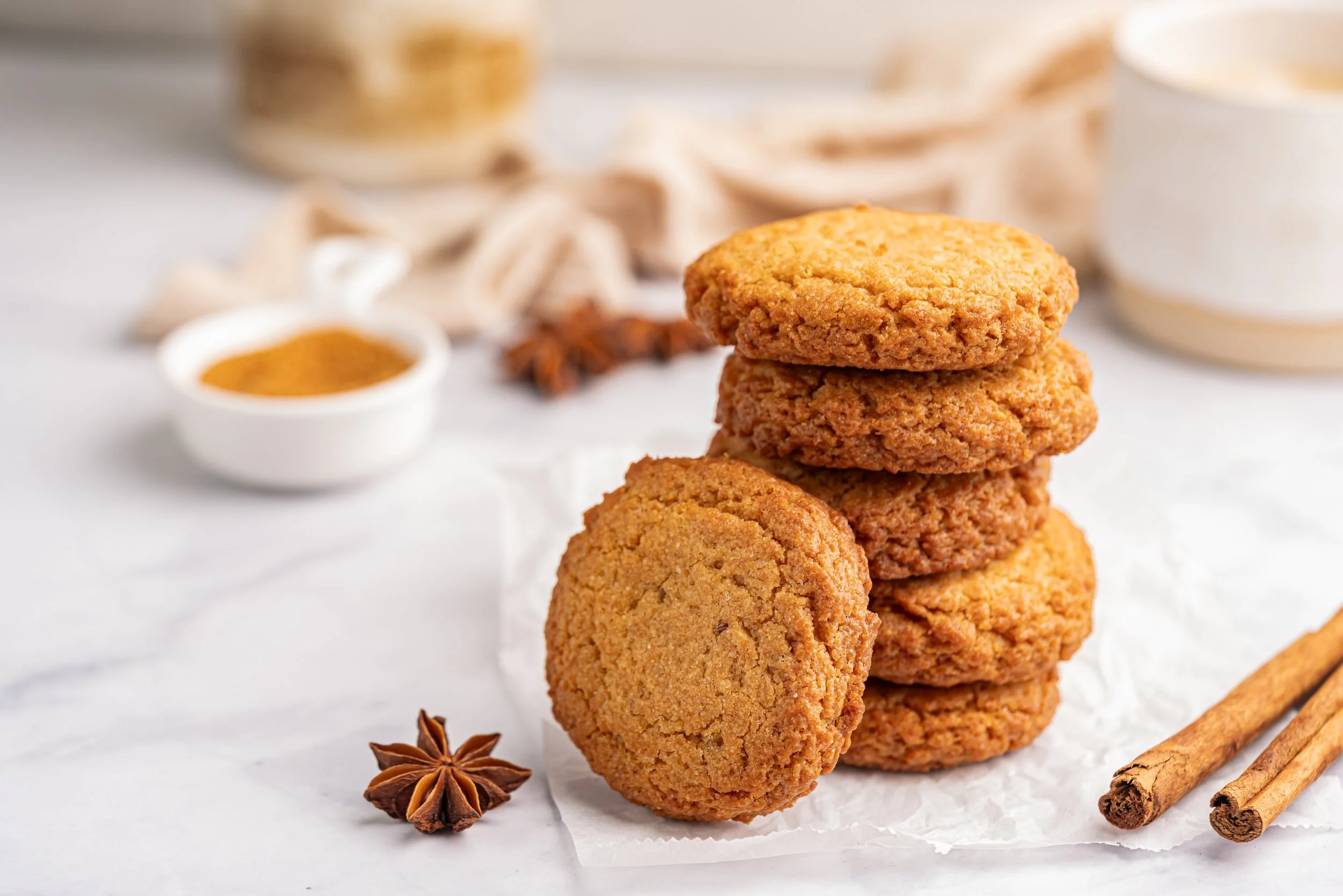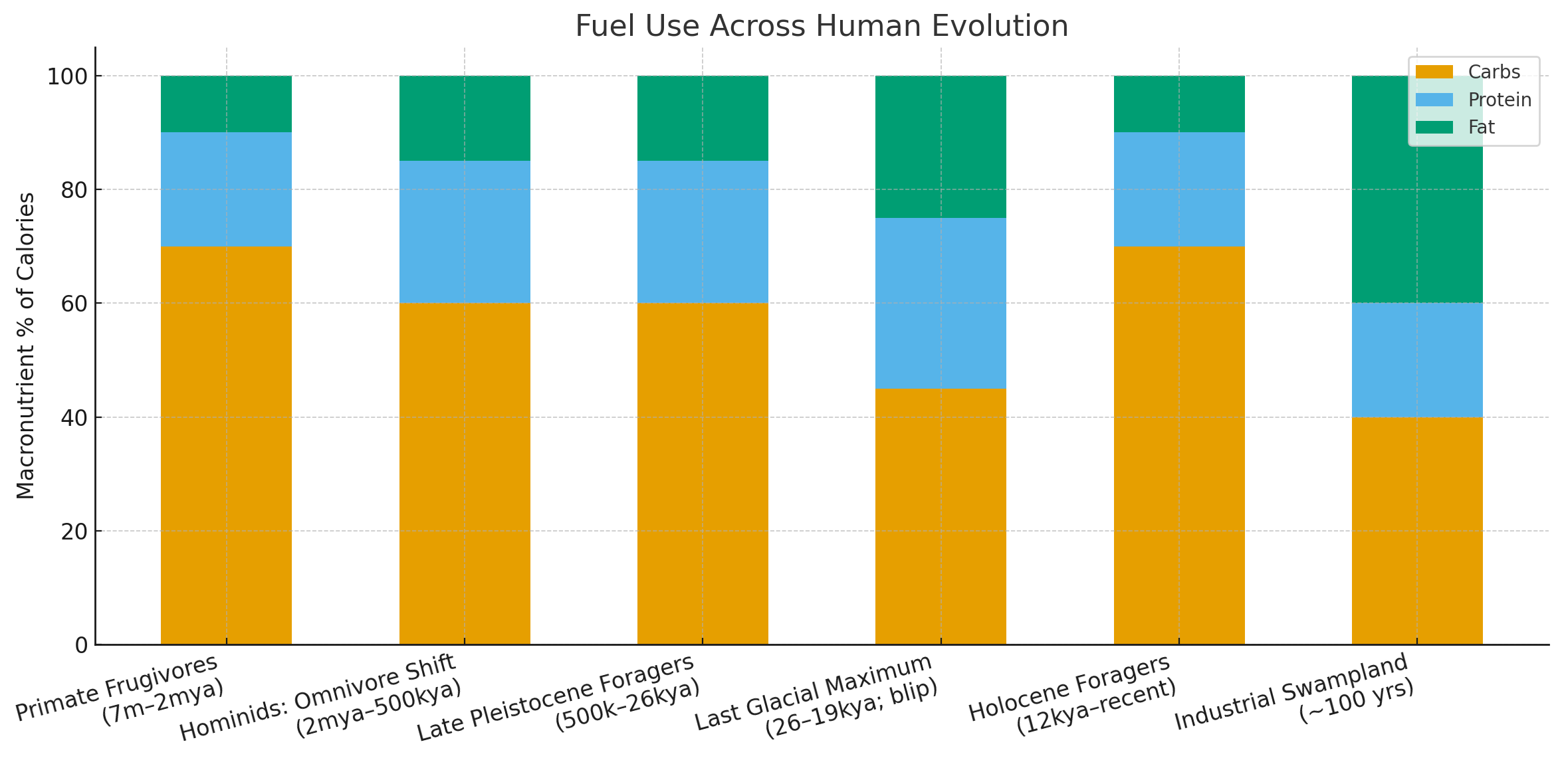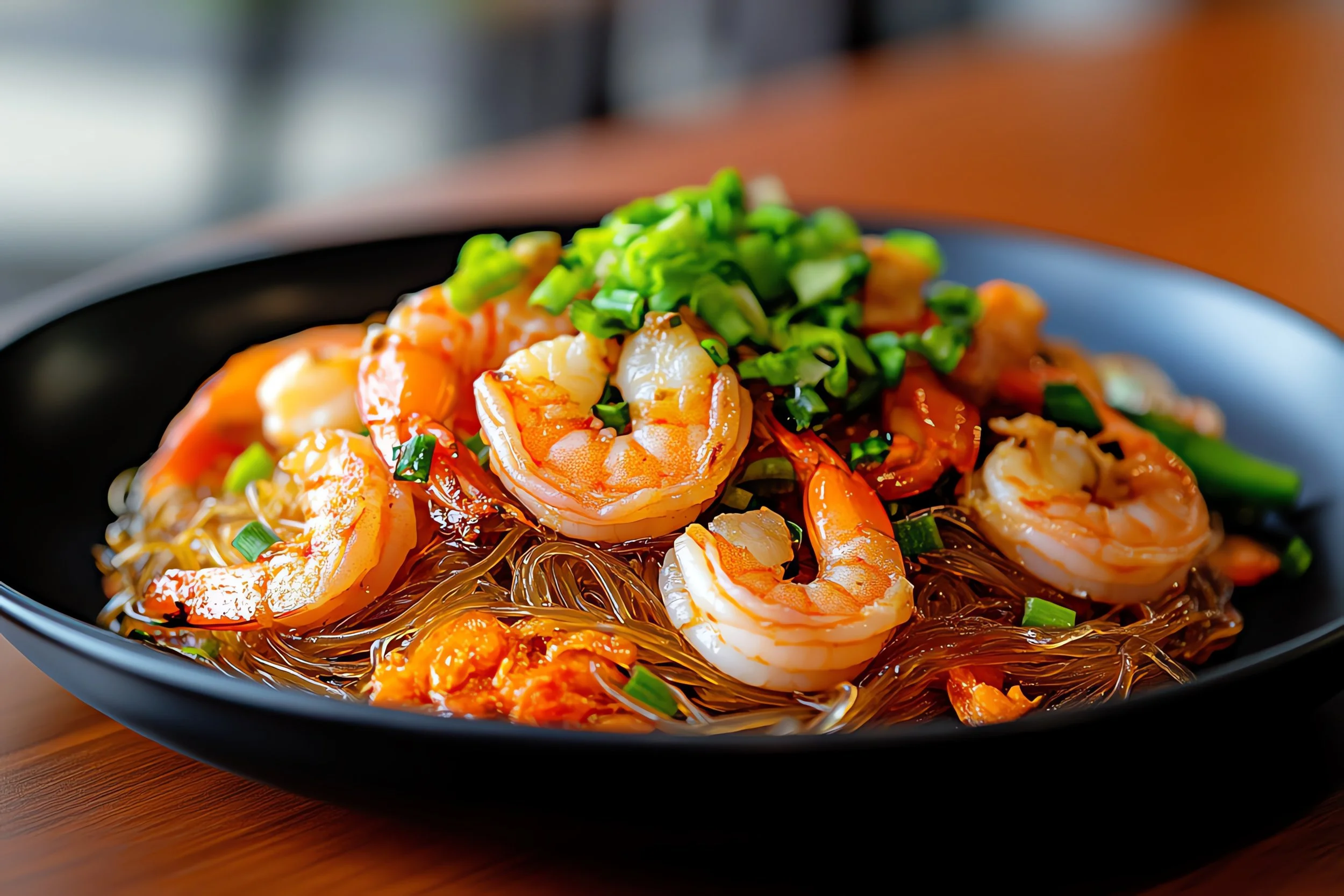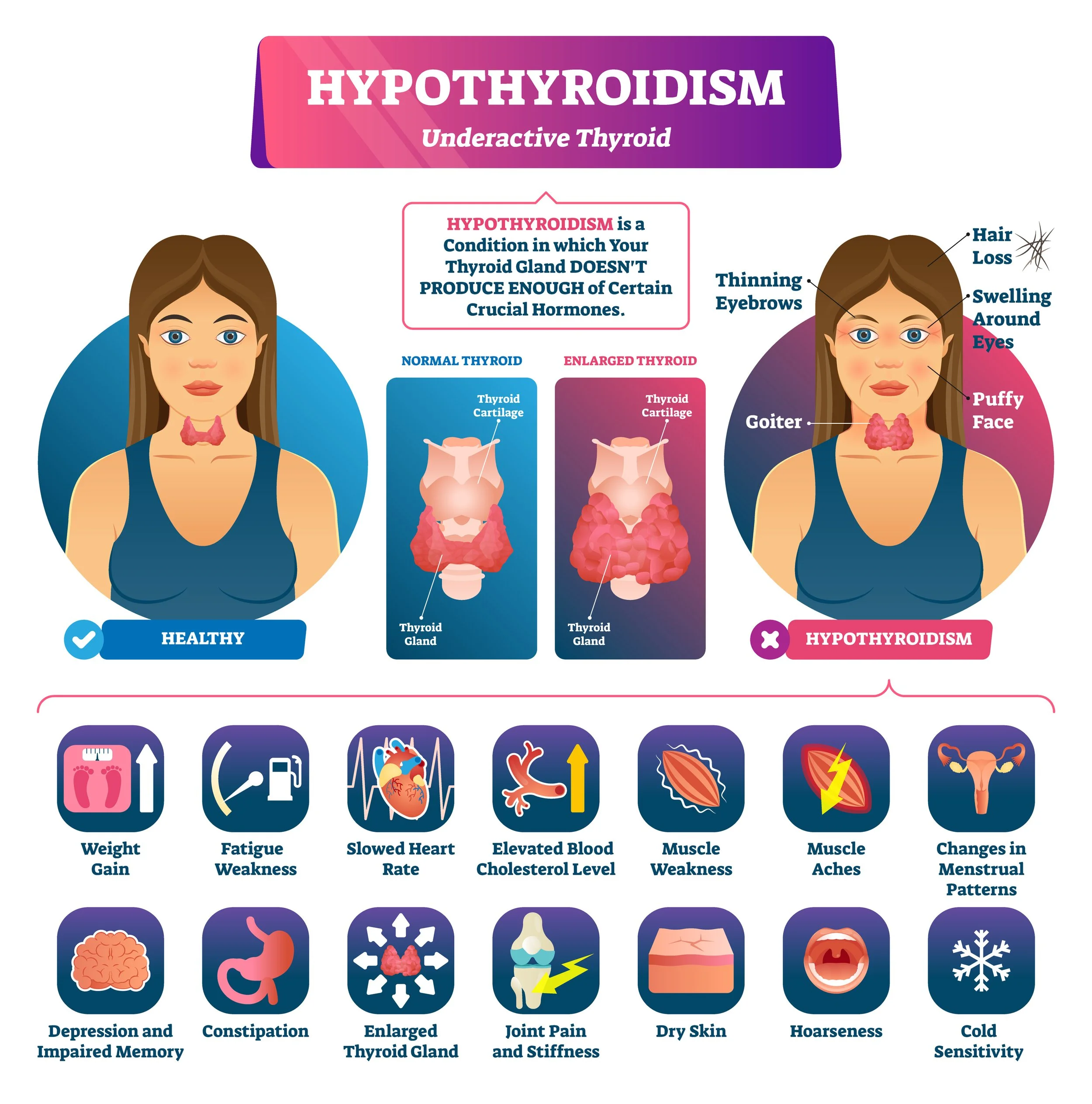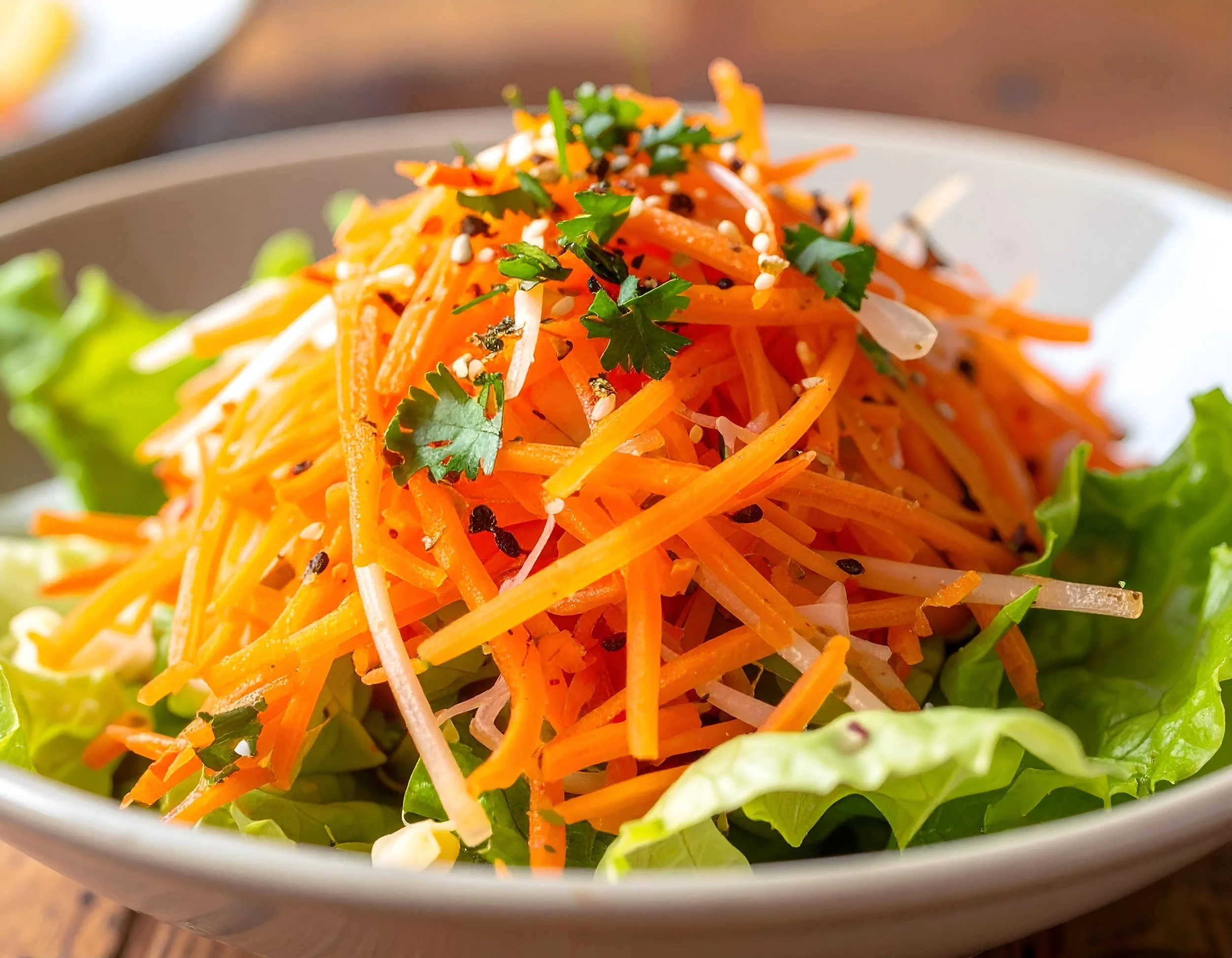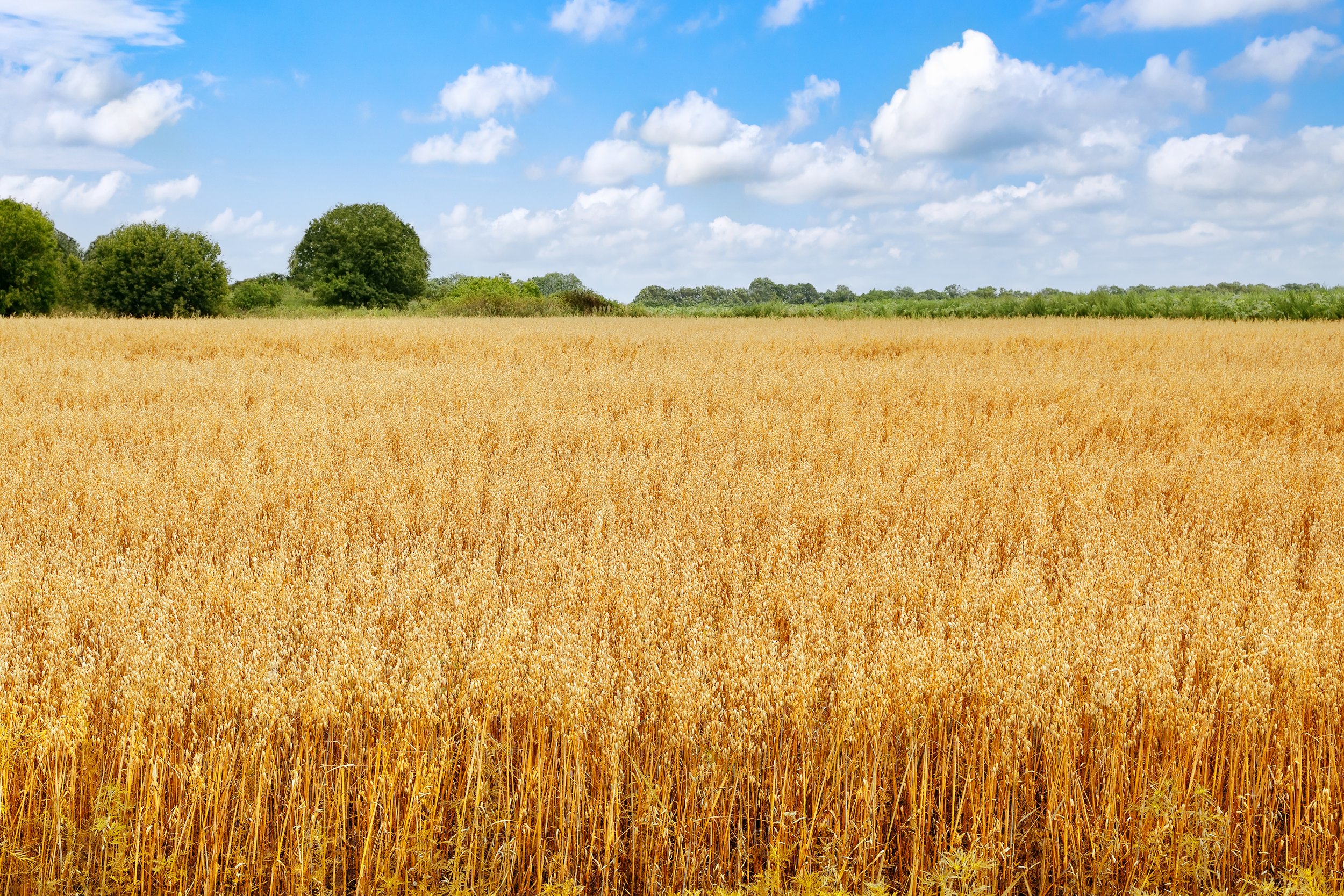The Hidden Metabolic Dangers of GLP-1 Drugs — And the Better Way Out
There is a better way to lose weight than starving your body and slowing your metabolism.
Ozempic, Wegovy, and other GLP-1 medications have exploded in popularity because they promise something that feels almost magical: quick, effortless weight loss without needing to think about food. For someone who has struggled with cravings, slow weight loss, or metabolic frustration, it can feel like the breakthrough they’ve been waiting for. But beneath the surface, these drugs do not address the real reason weight gain happened in the first place. They suppress appetite rather than restoring metabolic function, digestion, thyroid health, or hormonal balance. The deeper issue is not excessive eating; it is insufficient metabolism. Most Americans have a damaged metabolism from seed oils (which are machinery lubricant and currently make up 20% of the American diet), and are running on low thyroid output, sluggish digestion, chronically low energy availability, and diets far too high in fat for their physiology to handle. When metabolism slows, the body stores energy rather than burns it, and weight gain becomes almost effortless.
GLP-1 Drugs Slow Metabolism Rather Than Repairing It
The core problem with GLP-1 drugs is not that they cause weight loss, but how they cause it. They work by shutting down appetite so strongly that many people unintentionally eat far below what the body needs to function. This level of under-eating mimics clinical starvation, and the body responds the way it always does under starvation conditions. Thyroid hormone production drops, body temperature falls, digestion slows, bile thickens, and the detoxification of estrogen and other metabolites becomes impaired. Cortisol rises to compensate for the lack of available fuel, and muscle tissue is broken down for energy. Nothing about this state reflects healing. It reflects conservation and survival.
Most Americans Gain Weight Because Their Metabolism Is Slow, Not Because They Overeat
The cultural message that “people are overweight because they eat too much” is misleading and incomplete. In reality, many Americans consume far more dietary fat than their metabolism is equipped to handle. High-fat intake slows digestion, suppresses mitochondrial efficiency, reduces glucose uptake, and interferes with T4-to-T3 thyroid conversion. Over time, this combination leads to digestive stagnation, low body temperature, hormonal imbalances, and impaired metabolic flexibility. These are the hallmarks of a slow, cold metabolism. Once someone is in this state, weight gain can occur even when calorie intake is not excessive. The body simply does not burn fuel well, and the fuel it cannot burn is stored.
GLP-1 drugs push people deeper into this suppressed metabolic condition. They do not fix the slow thyroid function, sluggish digestion, or impaired carbohydrate metabolism that caused the problem. They amplify it by further reducing caloric intake and slowing gastric emptying even more. The result is a metabolism that becomes increasingly fragile.
Why Rebound Weight Gain Happens After Stopping GLP-1 Drugs
When someone stops taking a GLP-1 medication, appetite returns quickly because the body is trying to correct a prolonged energy deficit. But the metabolic rate does not rebound nearly as fast. Thyroid output remains low, digestion remains slow, muscle mass has often been lost, and cortisol remains elevated. The body begins storing calories rapidly because it has been trained for months to conserve energy. This is why nearly everyone regains weight after stopping these medications, and why many regain more than they lost. This outcome is not a personal failure. It is the natural physiological response to prolonged metabolic suppression.
The Hopeful Truth: Metabolism Can Be Rebuilt
The good news is that the problems that cause weight gain are fixable, and far more fixable than most people realize. A slow metabolism can be restored. A sluggish thyroid can be supported. Digestion can be repaired. Muscle can be rebuilt. Temperature can rise. Energy can return. Appetite can normalize. When the body is given the right support, it becomes naturally inclined toward fat loss because it begins to burn rather than store.
Raising metabolism begins by improving thyroid function — often with natural desiccated thyroid or carefully dosed combinations of T3 and T4 to restore normal hormone signaling. As thyroid function improves, body temperature rises, cellular energy increases, bile becomes thinner, digestion speeds up, and estrogen detoxification becomes more efficient. These changes often happen quickly and can feel dramatic. People notice warmer hands and feet, more stable moods, better digestion, and a return of natural hunger cues that align with stable blood sugar rather than cravings. Side-note: Just because you doctor told you your thyroid is “fine” doesn’t mean that it is, chronically low metabolism lowers Free T3 (active thyroid hormone) and modern medicine only tests TSH and only prescribes T4 medications like Synthroid - which does not fix the problem or tell you how well your thyroid is functioning. Most Americans are hypothyroid and have body tempertures lower than 98.6 in the morning and free T3 below 3.4 from depressed metabolism.
Understanding Energy Availability: The Scientific Foundation of a Fast Metabolism
A core part of restoring metabolism is understanding energy availability, or EA, which measures how much usable energy remains for thyroid function, hormone production, digestion, and cellular repair after accounting for movement. The research here is remarkably consistent: humans require at least 43 calories per kilogram of lean body mass to sustain a healthy metabolic rate. When energy intake falls below this threshold, the body automatically begins shutting down nonessential functions to conserve fuel. Thyroid conversion drops, body temperature decreases, digestion slows, and cortisol rises — all of which make fat loss nearly impossible. To calculate your personal minimum EA, you simply take your lean body mass in kilograms and multiply by 43. For many women, this places true metabolic maintenance between 1,900 and 2,400 calories per day, often significantly higher than what they’ve been eating for years.
Meeting this requirement is not about overeating; it is about eating in the right balance. A simple and reliable template is to aim for one gram of protein per pound of lean body mass, which supports muscle, thyroid function, and metabolic stability. Dietary fat should generally sit around 0.8 grams per pound of lean mass or lower (some people do ok on more), because lowering fat is the safest, most reliable way to increase calories without gaining body fat. When fat is reduced first — especially when seed oils, fried foods, nut milks, nut butters, and processed fats are removed — the body becomes dramatically more efficient at oxidizing carbohydrates. Eating real, whole foods and avoiding industrial seed oils improves insulin sensitivity, enhances bile flow, and prevents the “calorie spillover” that causes fat storage. With protein and fat appropriately set, the remainder of calories should come from carbohydrates. Carbs are indispensable for restoring T3 production, improving digestive motility, raising body temperature, and supporting progesterone and thyroid hormone activity. When EA rises to physiologic levels and the macronutrient distribution is aligned with human metabolism, the entire hormonal system shifts out of famine mode and back into a warm, fat-burning, high-energy state — often with noticeably improved digestion, steadier moods, better sleep, and a renewed sense of vitality.
After a period of restoration in full EA, it is safe to do short, strategic fat-loss periods (I usually recommend 2 weeks at a time) to drop body fat and retain muscle mass. In the body building world, this is called a “cut” and is done in a way that keeps protein and carbs as high as possible to protect the metabolism and thyroid. The literature is very clear that reduces calories for a long period of time - a standard diet, or what occurs on GLP-1 medications - is a starvation state and is extremely hard on the body. It reduces metabolism, impairs hormone health, leads to insomnia and high cortisol, creates depression and anxiety, causes gut problems and slow digestion, and lowers body temperature.
Lowering Dietary Fat and Learning to Burn Carbohydrates Is Essential
Another essential piece of metabolic rehabilitation is reshaping the macronutrient profile away from excessive fat and toward carbohydrates that the body can burn efficiently. Carbohydrates support thyroid conversion, improve mitochondrial function, stabilize blood sugar, increase progesterone, and elevate metabolic rate. When dietary fat is lowered to metabolically appropriate levels, digestion improves, bile flows freely, and the cells regain the ability to oxidize glucose. Many people discover that they were never “carb intolerant.” They were simply eating far too much fat and poisoned by seed oils, which blocked their ability to burn carbohydrates properly. Once this metabolic traffic jam is removed, weight loss becomes much easier.
Restoring Digestion and Motility Is a Cornerstone of Long-Term Fat Loss
Improving digestion is another central pillar of restoring a fast metabolism. When motility increases, stomach acid and enzymes rise, bile circulates properly, and nutrients can finally be absorbed. This leads to improved hormonal function and more stable energy. It also reduces estrogen recirculation, a major contributor to weight gain, PMS, heavy cycles, and bloating. Unlike GLP-1 drugs, which slow digestion dramatically, metabolic restoration speeds digestion in a way that supports sustainable fat loss and overall health.
The Real Solution Is Not Eating Less — It Is Metabolizing More
Weight loss becomes sustainable when the body can burn energy at a higher rate. This happens when thyroid function is strong, digestion is efficient, and dietary fat is not overwhelming the system. It happens when the metabolism feels safe, nourished, and warm. It happens when muscle is supported rather than wasted, when bile flows smoothly, when estrogen detoxifies properly, and when carbohydrates are being metabolized instead of feared.
GLP-1 drugs cannot create this environment. They can only suppress it.
Metabolic restoration, however, can transform it. When the body burns hotter and runs faster, weight loss becomes a natural, effortless extension of health rather than a fight against biology. This is why the answer is never long-term under-eating or slowing digestion. The answer is building a body that burns fuel easily, joyfully, and consistently — a body that has the metabolic flexibility and thyroid-driven energy it was always meant to have.
References:
GLP-1 RAs, delayed gastric emptying & long half-life (mechanism overview)
Shankar A, Chinthapalli S, Jose T, et al. Glucagon‐like peptide‐1 receptor agonists and delayed gastric emptying: implications for invasive cardiac interventions and surgery. Cardiovasc Endocrinol Metab. 2024;14(1):e00321.
https://pmc.ncbi.nlm.nih.gov/articles/PMC11620716/
GLP-1 agonists slow gastric emptying and small-bowel motility, have very long half-lives, and can leave food in the stomach despite fasting.
Clinical consequences of delayed gastric emptying on GLP-1s (human data)
Jalleh RJ, Plummer MP, Marathe CS, et al. Clinical Consequences of Delayed Gastric Emptying With GLP-1 Receptor Agonists and Tirzepatide. J Clin Endocrinol Metab. 2025;110(1):1–15.
https://academic.oup.com/jcem/article/110/1/1/7824836
Shows that delayed gastric emptying on GLP-1s is not just theoretical — they summarize evidence for retained gastric contents, aspiration risk, and altered nutrient handling with these drugs.
How much do GLP-1s actually slow gastric emptying? (meta-analysis)
Hiramoto B, McCarty TR, Lodhia NA, et al. Quantified metrics of gastric emptying delay by glucagon-like peptide-1 agonists: a systematic review and meta-analysis with insights for periprocedural management. Am J Gastroenterol. 2024;119(7):1126–1140.
This paper quantifies how much GLP-1s slow gastric emptying and discusses practical implications for procedures - this isn’t just appetite, it’s mechanical slowing of the gut.
Semaglutide: energy intake, appetite, and gastric emptying in obesity
Friedrichsen M, Breitschaft A, Tadayon S, et al. The effect of semaglutide 2.4 mg once weekly on energy intake, appetite, control of eating, and gastric emptying in adults with obesity. Diabetes Obes Metab. 2021;23(3):754–762.
https://pubmed.ncbi.nlm.nih.gov/33269530/
Use it for: direct evidence that semaglutide cuts calorie intake and slows gastric emptying rather than “fixing metabolism” — it’s appetite suppression + slowed gut transit, not a restoration of normal metabolic flexibility.
Weight regain after stopping semaglutide (STEP 1 extension)
Wilding JPH, Batterham RL, Calanna S, et al. Weight regain and cardiometabolic effects after withdrawal of semaglutide: The STEP 1 trial extension. Diabetes Obes Metab. 2022;24(8):1553–1564.
https://pubmed.ncbi.nlm.nih.gov/35441470/
After stopping semaglutide, participants regained most of the weight within a year and cardiometabolic markers drifted back toward baseline.
GLP-1s, endoscopy, and residual gastric contents (procedural risk)
Crespo J, Jiménez-García VA, Díez-Redondo P, et al. GLP-1 Receptor Agonists and Gastrointestinal Endoscopy. J Clin Med. 2025;14(15):5597.
https://www.mdpi.com/2077-0383/14/15/5597 MDPI
Discussion of higher rates of solid gastric residue and aspiration concerns in GLP-1 users during endoscopy. Slowed motility is clinically significant.
Low energy availability → low T3 + metabolic downshift (foundational thyroid piece)
Loucks AB, Callister R. Induction and prevention of low-T3 syndrome in exercising women. Am J Physiol. 1993;264(5 Pt 2):R924–R930.
https://pubmed.ncbi.nlm.nih.gov/8160876/
Shows that low energy availability itself (not just exercise) rapidly suppresses T3 and raises rT3, independent of thyroid gland disease. GLP-1-induced chronic undereating will push people toward a low-T3, low-metabolic state. Humans need a minimum of 43 cal/kg of LBM to be out of malnourishment. This is 2000-2500 cal for most women and close to 3000 for most men (with adequate muscle).
Microbiome, estrobolome & estrogen recirculation (for your estrogen detox angle)
Plottel CS, Blaser MJ. Microbiome and malignancy. Cell Host Microbe. 2011;10(4):324–335.
https://www.sciencedirect.com/science/article/pii/S1931312811002964
Introduces the “estrobolome” concept (gut microbes that deconjugate estrogens and recirculate them) and ties GLP-1-induced motility changes and reduced food volume to stagnant estrogen detox and higher estrogen burden.
The Metabolic Problem with Excess Protein
How Much You Really Need in Maintenance, Cutting, and Everyday Metabolism
Most people dramatically overestimate how much protein the human body can process without stress. High-protein diets have been promoted for decades in bodybuilding, fat loss programs, and low-carb circles, but the biochemical reality is far more nuanced. Excess protein—whether from muscle meat, eggs, dairy, whey, or even collagen—places a significant burden on the liver, raises stress hormones, increases serotonin, suppresses thyroid function, and shifts metabolism into a pattern that looks uncannily like low-grade hypothyroidism. Ray Peat spent years clarifying this misunderstanding: the body needs adequate protein, but excess is a metabolic liability, not an advantage.
This article walks through the science, numbers, and practical ranges for protein intake during bulking, cutting, and metabolic healing, all while integrating the Peat-aligned principles of oxidative metabolism, amino acid balance, CO₂ production, and thyroid physiology.
Why Excess Protein Is a Metabolic Stressor
When protein intake rises above the body’s anabolic needs, several predictable physiological mechanisms activate. The first is ammonia accumulation. Every amino acid that is not incorporated into tissue structure must undergo deamination in the liver. This produces ammonia, which is toxic, neurologically stimulating, and metabolically expensive to clear through the urea cycle. Ammonia load increases brain fog, irritability, fatigue, and mitochondrial inefficiency. The urea cycle is ATP-demanding, meaning excess protein indirectly lowers energy availability for tissues.
Protein also stimulates insulin without providing usable carbohydrate. When insulin rises in the absence of glucose, blood sugar falls. The result is a compensatory surge in cortisol and adrenaline, the two major catabolic stress hormones. This is why high-protein/low-carb diets produce anxiety, irritability, cold extremities, slow digestion, and insomnia. Cortisol blocks T4-to-T3 conversion in the liver, pushing thyroid physiology downward. Even when carbohydrates are present, very high protein loads still provoke higher basal cortisol as the body attempts to manage nitrogen waste and blood glucose stability.
Another problem is serotonin. All protein contains tryptophan, and Dr Ray Peat repeatedly emphasized that excess tryptophan and serotonin suppress mitochondrial respiration. Serotonin slows gastrointestinal motility, promotes inflammation, and interferes with thyroid hormone signaling. Even “clean” proteins like dairy, eggs, fish, and collagen contribute to tryptophan unless balanced by adequate carbohydrate and glycine. Excess protein of any form therefore increases serotonin load unless countered by a high-carbohydrate environment.
Protein oxidation also generates relatively low CO₂ compared to carbohydrate oxidation. CO₂ stabilizes cell metabolism, supports mitochondrial function, and maintains proper blood flow. Lower CO₂ from high protein intake means poorer oxidative metabolism, colder body temperatures, and a metabolic shift that resembles chronic stress. The high sulfur amino acids in protein (methionine, cysteine) raise homocysteine, antagonize thyroid function, and increase urinary calcium excretion.
Finally, high protein chronically activates mTOR, an anabolic switch that is useful in acute muscle-building contexts but harmful when persistently elevated. Chronic mTOR activation reduces autophagy and increases the risk for inflammatory and degenerative tissue states.
In short, excess protein increases ammonia, serotonin, nitric oxide, cortisol, liver burden, and thyroid suppression while decreasing carbon dioxide, oxidative metabolism, and metabolic stability. The modern obsession with ultra-high protein diets is not only unnecessary but counterproductive for metabolic function.
How Much Protein Is Actually Needed? The Peat-Aligned Range
Ray Peat consistently gave real-world numbers: most adults function best at 80–100 grams of protein per day, with 120 grams as the upper boundary for very large men. This is supported by nitrogen balance research showing that the human body saturates its protein synthesis capacity at relatively modest intakes. Above this threshold, the additional protein is burned for energy—or worse, converted into glucose through cortisol-dependent gluconeogenesis.
An 80–100 gram per day range provides enough amino acids for tissue repair, enzymatic function, detoxification, hormone transport, and structural maintenance. It avoids the ammonia burden and stress response that emerges at higher levels. It also supports thyroid function because the liver is not overwhelmed with excess nitrogen and sulfur processing.
Peat emphasized amino acid balance as much as total quantity. Approximately one-third to one-half of daily protein should come from gelatin, collagen, dairy proteins, or shellfish to balance the methionine-rich profile of muscle meat. Gelatin and glycine offset methionine’s inflammatory and thyroid-suppressive effects, lowering cortisol and supporting better sleep and digestion.
Protein Needs During Maintenance/Bulking: Not as High as You Think
Even during deliberate muscle-building phases, protein requirements do not rise dramatically. Research in resistance-trained adults demonstrates that maximal muscle protein synthesis occurs at approximately 1.6–1.8 g/kg of lean body mass—not total bodyweight. For a 70-kg individual with 55 kg of lean mass, this equates to roughly 90–100 grams of protein per day, aligning perfectly with Peat’s recommendations.
More protein does not mean more muscle. When carbohydrate intake is high and energy availability is adequate, muscles oxidize glucose efficiently and spare amino acids for repair and hypertrophy. The stimulus for muscle growth is resistance training plus energy surplus, not protein excess. As long as total calories are adequate and carbohydrates dominate fuel metabolism, 90–110 grams of daily protein is sufficient for hypertrophy.
Eating more protein than this does not accelerate growth. It increases ammonia, cortisol, and metabolic burden, ultimately slowing progress.
Protein Needs During Cutting: Lower Protein Preserves Metabolism
During energy restriction, the popular advice is to increase protein to “protect muscle.” The biology tells a different story. Very high protein during a cut increases cortisol because amino acids must be burned or converted to glucose in a calorie-deficient environment. Cortisol accelerates muscle breakdown and suppresses thyroid conversion, making fat loss harder and metabolic recovery slower.
Research from intermittent energy restriction models, MATADOR-style cycling, and athlete-based metabolic studies shows that maintaining normal—not elevated—protein intake preserves lean mass when carbohydrate intake is sufficient and energy availability is not chronically suppressed.
During a cut, Peat-aligned physiology works best around 0.9–1.2 g/kg of lean body mass. For many adults, this means 70–95 grams per day. Carbohydrates should remain high enough to maintain glycogen, support thyroid conversion, and blunt cortisol. Fat should remain low to preserve oxidative efficiency and prevent metabolic slowdown.
The key point is that protein does not need to rise during a cut. If anything, moderation protects thyroid function.
When to Eat More Protein (and When Not To)
Protein should rise modestly only when energy availability is high and carbohydrate intake is abundant. This occurs in:
deliberate bulking phases
high-calorie maintenance periods
periods of heavy resistance training with adequate sleep
Protein should not increase when:
calories are low
carbs are low
stress hormones are high
liver function is impaired
thyroid function is suppressed
digestion is compromised
These are the states where excess protein converts to cortisol, ammonia, serotonin, and stress.
The body thrives when carbohydrates are primary, protein is moderate and balanced, and fat remains the smallest energy contribution.
Conclusion
Excess protein is not harmless. It is metabolically expensive, thyroid-suppressive, and inflammatory when intake exceeds what the body can use for repair and enzymatic function. Ray Peat consistently emphasized that the optimal protein intake lies between 80 and 100 grams per day for most adults, with an upper boundary around 120 grams for large males. Even during muscle building, this range is sufficient when energy and carbohydrate intake are high. During cutting, protein should not increase; instead, it should remain moderate to prevent cortisol elevation and preserve thyroid function.
The modern fixation on very high protein diets contradicts both basic physiology and the energetically driven model of human metabolism. Moderation, balance, and carbohydrate dominance remain the most effective approach for metabolic resilience, thyroid support, and body recomposition.
References
Peat, R. various newsletters and interviews, Ray Peat Forum archives
Roddy, D. articles and interviews on metabolic and thyroid physiology
Haidut (Georgi Dinkov), Idealabs interviews and scientific commentary
Gorissen et al., "Protein requirements in trained individuals," Journal of Nutrition
Morton et al., "A systematic review on protein intake and resistance training," British Journal of Sports Medicine
Loucks, A. “Energy Availability and the Female Athlete,” Medicine & Science in Sports & Exercise
Bell et al., "Intermittent energy restriction and fat-free mass retention," International Journal of Obesity
🦃 Traditional Turkey Gravy (with Quick Stovetop Organ Broth)
This is the way gravy was always made before boxed broths, seed oils, and flavor packets took over. You simmer the turkey organs with simple aromatics, build a deeply savory broth in under an hour, whisk it into your pan juices, and finish with just enough butter to make it silky.
It tastes rich, but doesn’t sit heavy — exactly how traditional gravy should be.
Ingredients
Quick Organ Broth
Neck + giblets from your seed-oil-free turkey
1 small carrot, chopped
1 celery stalk, chopped
1 small onion, quartered
1–2 garlic cloves, smashed (optional)
1 bay leaf
6 cups water
Salt + pepper to taste
Gravy Base
Turkey pan drippings (whatever amount you naturally have)
2–3 tbsp sourdough starter OR arrowroot powder if needed
2–3 cups organ broth (from above)
1–2 tbsp butter (just enough for that glossy, traditional finish)
Salt + pepper to taste
Optional: splash of white wine or lemon juice for brightness
Optional: minced fresh herbs (thyme, parsley, sage)
Instructions
1. Make the Organ Broth
Add the turkey neck, giblets, carrot, celery, onion, garlic, bay leaf, and water to a medium pot.
Bring to a boil, then reduce heat and simmer 45–60 minutes.
Skim any foam.
Strain and reserve the broth.
Chop the liver/heart finely if you want to blend them into the finished gravy for extra flavor (old-school style).
This broth is insanely flavorful and makes the gravy taste like it cooked all day.
2. Make the Gravy
After roasting your turkey, pour the pan drippings into a measuring cup.
Skim off excess fat if needed — leave a little for flavor.
Place the roasting pan on the stovetop over medium heat (or use a skillet).
Add the drippings back in and whisk in 2–3 tbsp flour to form a loose roux.
Cook 2–3 minutes until it smells toasty.
Slowly whisk in 2–3 cups of your organ broth, letting it thicken as it heats.
Simmer 5–10 minutes until silky.
Stir in 1–2 tbsp butter to finish.
Salt and pepper to taste.
Blend in chopped giblets or herbs if you love it rustic.
Notes
Arrowroot works if you want a gluten-free gravy, but add it at the end with a quick simmer (it gets weird if boiled too long).
If you like it extra glossy, whisk in an extra ½ tbsp butter at the end — that’s literally all traditional gravy needs to taste rich.
If it gets too thick, splash in more broth or water.
If it’s too thin, simmer a few minutes longer or whisk in a tiny slurry of flour + broth.
Optional Add-Ins
Squeeze of lemon for brightness
Splash of wine for depth
Fresh thyme or sage minced finely
A teaspoon of honey if you want a slightly sweeter, more old-fashioned flavor
🍕Low-Fat Chicken Crust Pizza
Yes, this recipe is basically keto — but stay with me, because this one actually has a purpose. This low-fat chicken crust pizza is designed for the people (maybe your friends, maybe your keto parents who still think carbs cause obesity 😘) who can’t tolerate sourdough, rice, or starches yet while they’re still healing their gut, reversing restrictive dieting history, or working through IMO/SIBO recovery.
It’s not meant to be a lifestyle. It’s a temporary bridge food for the “between phase” — when your gut isn’t ready for starch, but you still want something comforting and savory that doesn’t wreck your digestion or blow your fat budget.
And because it is technically keto but we’re not doing that anymore, the solution is simple:
👉 Drink a big glass of lemonade with it.
Easy carbs, zero gut drama, still metabolically supportive.
This pizza also happens to be the perfect “peace offering” meal when your keto parents come over for dinner and are secretly judging your orange juice. Serve them this high-protein, low-fat, digestively gentle pizza… then sip your lemonade and smile, knowing you’re living in 2025 and they’re still stuck in 2017. 😉
Once your gut is healed and you’re tolerating starch again, go back to your sourdough or gluten-free rice crust — but for now, here’s a low-fat pizza that actually works.
Ingredients
Chicken Crust
1 lb ground chicken breast
1 egg white (optional, helps bind)
½–1 tsp salt
½ tsp garlic powder
½ tsp onion powder
½ tsp oregano
¼ tsp black pepper
(Option: 1–2 tbsp grated parmesan for flavor with minimal added fat.)
Toppings
¼–⅓ cup clean marinara or crushed tomatoes
Turkey pepperoni (very low fat)
Part-skim OR fat-free mozzarella, shredded
Use a small amount - like ½ cup
Fresh basil (optional)
How to Choose a Clean Light Mozzarella
Best Ingredients (✔️ clean):
skim milk
milk protein concentrate
salt
citric acid
calcium chloride
enzymes
Avoid (added junk):
modified food starch
gums (guar, xanthan, locust bean)
maltodextrin
potato starch
artificial colors
long ingredient lists
Look for the shortest ingredient list — ideally just milk, enzymes, salt, and citric acid.
Instructions
1. Make the Crust
Preheat oven to 400°F.
Mix ground chicken with spices (and egg white if using).
Line a baking sheet with parchment.
Press chicken mixture into a thin, even crust (¼–⅓ inch thick).
Bake 20–25 minutes, until cooked through and lightly browned.
2. Add Toppings
Spread marinara or crushed tomatoes over the cooked crust.
Add a light sprinkle of mozzarella (fat-free or part-skim), then turkey pepperoni.
3. Bake Again
Return to the oven for 8–10 minutes until the cheese melts.
Broil for 1–2 minutes if you want browning.
4. Slice + Enjoy
Let it cool 2–3 minutes for easier slicing.
Top with fresh basil or red pepper flakes.
Macros (Entire Pizza)
Using 1 lb 99% lean chicken, ⅓ cup fat-free mozzarella, light turkey pepperoni:
Calories: ~520–560
Protein: 90–100g
Carbs: 10–15g
Fat: 8–12g
(Part-skim mozzarella adds ~3–4g more fat per ⅓ cup.)
Notes for Variation
Adding ricotta dollops works for clients who prefer creamy over melty.
Fat-free mozzarella melts better than most expect — great for cut phases.
Part-skim mozzarella gives the most authentic pizza flavor with very little fat.
Increase protein even further by adding extra turkey pepperoni or mixing 1 scoop collagen into the marinara before spreading.
🍠 Sweet Potato Bake with Homemade Maple Marshmallows
This is the Thanksgiving dish you don’t have to feel conflicted about — because it’s actually pro-metabolic at its core. Our great-grandparents made meals built around lean protein, tubers, real sugar, low fat, and whole-food carbs long before “metabolic health” was even a term.
A plate of turkey breast, low-fat pan gravy, sourdough stuffing, sweet potatoes, cranberry sauce, and pumpkin pie is shockingly close to the exact macro pattern that supports thyroid function, stable blood sugar, liver glycogen, and warm hands. This sweet potato bake fits right into that ancestral blueprint — whipped, silky potatoes sweetened with mineral-rich maple syrup and topped with gut-friendly homemade gelatin marshmallows. It’s nostalgic, festive, and metabolically aligned without sacrificing flavor or tradition.
Ingredients
Sweet Potato Base
3 large sweet potatoes, peeled & cubed (about 3 lbs)
2–3 Tbsp butter (optional but recommended)
1/4 cup maple syrup
1/4 cup orange juice
2 tsp vanilla extract
1/2 tsp salt
Optional: 1/2 tsp cinnamon or pumpkin pie spice
Homemade Maple Marshmallows
(Fluffy, clean, gut-friendly gelatin marshmallows)
1 cup maple syrup
1/2 cup water, divided
3 Tbsp grass-fed gelatin
1 tsp vanilla
Pinch of salt
Note: Commercial clean marshmallows are rare. The only borderline options with decent ingredients use tapioca syrup + gelatin (e.g., some paleo brands), but they still add weird stabilizers. Making your own is genuinely the cleanest.
Instructions
1. Make the Sweet Potato Base
Preheat oven to 375°F.
Boil sweet potatoes until soft (10–12 minutes), then drain.
Add:
Butter
Maple syrup
Orange juice
Vanilla
Salt
Optional spices
Mash or whip with a hand mixer until smooth and silky.
Spread into a casserole dish.
2. Make the Marshmallows
In a mixing bowl, add:
3 Tbsp gelatin + 1/4 cup water.
Let it bloom.In a saucepan, heat:
1 cup maple syrup
1/4 cup water
Pinch of salt
Bring to a boil, then cook until 240°F (soft-ball stage).
Slowly pour the hot syrup into the gelatin while mixing on high.
Beat 8–10 minutes until thick, glossy, marshmallowy.
Spread on a lightly oiled parchment sheet and let set 2 hours.
Cut into cubes.
(You can also pipe the marshmallow directly onto the casserole if you want it extra rustic.)
3. Assemble & Bake
Add marshmallows on top of the sweet potato base.
Bake at 375°F for 12–15 minutes until golden on top.
If you like a toasted finish, broil for 20–30 seconds at the end.
Macros (approx., per serving of 8)
This depends on marshmallow size, but roughly:
Fat: 3–4g
Protein: 4–5g (from gelatin)
Carbs: 40–45g
Calories: ~210–230
🍁High-Protein Maple Marshmallows
These pro-metabolic maple marshmallows are everything store-bought marshmallows aren’t: no corn syrup, no additives, no seed oils, no refined sugar.
Just maple syrup, gelatin, water, vanilla, and salt — plus an optional collagen boost for extra protein.
They whip up exactly like classic marshmallows, but with a mineral-rich sweetener and a protein upgrade.
Why Gelatin Marshmallows?
Gelatin gives marshmallows their signature bounce, and it’s naturally rich in glycine — a pro-metabolic amino acid that supports gut lining, thyroid conversion, sleep, and collagen repair.
By increasing the gelatin (and adding a little collagen), you get a marshmallow that actually contributes to your protein intake while still being soft, fluffy, and perfectly sweet.
Ingredients
Base recipe:
1 cup maple syrup
2 tbsp grass-fed gelatin (for higher protein; see notes)
1/3 cup water (for blooming)
1 tsp vanilla extract
Pinch of salt
Optional protein boost:
2–4 tbsp collagen peptides, added during final whipping
Instructions
1. Bloom the gelatin
Add 1/3 cup water to the bowl of a stand mixer.
Sprinkle 2 tbsp gelatin evenly over the top and let it bloom for 5–10 minutes.
2. Heat the maple syrup
Pour 1 cup maple syrup into a small saucepan with a pinch of salt.
Bring to a gentle boil over medium heat and cook for 6–8 minutes, or until it reaches 240°F (soft-ball stage).
If you don’t want to use a thermometer, heat until it’s bubbling vigorously and thickening slightly.
3. Whip it
Turn the mixer to low to break up the bloomed gelatin.
Slowly pour the hot maple syrup down the side of the bowl.
Once everything is in, turn the mixer to high.
4. Whip until fluffy
Whip for 7–10 minutes until the mixture becomes light, glossy, and tripled in volume.
Add vanilla extract in the last 30 seconds.
Optional: Add 2–4 tbsp collagen peptides in the final 60 seconds of whipping for extra protein without changing the texture.
5. Pour and set
Line an 8×8 pan with parchment and lightly grease it.
Spread the marshmallow mixture evenly into the pan using a greased spatula.
Let it set at room temperature for 4 hours, or overnight.
6. Slice and store
Cut into squares with a knife dusted in arrowroot or gelatin (optional, but keeps edges clean).
Store in an airtight container for up to 5 days.
Protein + Macro Breakdown
With 2 tbsp gelatin + 4 tbsp collagen (protein-boost version):
Full batch:
Calories: ~966
Protein: 26g
Carbs: 210g
Fat: 0g
Per marshmallow (cut into 16 squares):
Calories: ~60
Protein: 1.6g
Carbs: ~13g
Fat: 0g
If you want to hit a different protein per piece, I can customize ratios.
Tips for Perfect Maple Marshmallows
Use Grade A dark maple for the richest flavor.
For a softer marshmallow, add 2 extra tablespoons of water to the bloom.
For a firmer, higher-protein marshmallow, increase gelatin to 3 tbsp (gummier and great for cocoa).
Maple scorches faster than sugar — if roasting, keep the flame low.
Mini cubes freeze beautifully for topping smoothies or hot chocolate.
FAQ
Can I make these without a stand mixer?
Yes — a powerful hand mixer works, you’ll just whip 1–2 minutes longer.
Can I use honey instead of maple?
Yes, but the flavor becomes stronger and they set a bit firmer.
Do marshmallows really need collagen?
No — it’s optional. Gelatin provides the structure; collagen simply bumps the protein without affecting texture.
🌽 Masa Harina Cornbread
If you want cornbread that’s easy to digest, low-fat, pro-metabolic, and made entirely from masa harina, this is it. No wheat flour, no seed oils, and no heavy fats weighing you down. Masa hydrates beautifully and gives you that classic cornbread flavor with a tender, moist crumb. Using 2 tablespoons of butter adds classic richness and better browning, but the recipe still works beautifully without it. Even with the butter included, this stays firmly in the low-fat category and pairs perfectly with pro-metabolic meals.
Ingredients
1 ½ cups masa harina
1 cup warm skim milk
½ cup orange juice
¼–⅓ cup sugar or maple syrup
2 tablespoons butter, melted
1 egg white
1 teaspoon baking powder
½ teaspoon baking soda
½ teaspoon salt
1 teaspoon vanilla (optional)
Instructions
Preheat oven to 375°F. Line an 8×8 baking pan with parchment.
In a bowl, whisk together the masa harina, baking powder, baking soda, and salt.
In a separate bowl, combine the skim milk, orange juice, sugar/maple syrup, melted butter (if using), egg white, and vanilla.
Pour the wet mixture into the dry mixture and stir until smooth. The batter should be thick but pourable; add a splash of milk if needed.
Spread evenly into the prepared pan.
Bake for 20–23 minutes, until the edges are lightly golden and the top springs back to the touch.
Cool for 10 minutes before slicing.
Notes & Tips
With butter: The crumb is richer, sweeter, and more classic.
Without butter: Still tender and moist thanks to the OJ and milk.
Orange juice improves softness and enhances corn flavor.
Keep fat low by serving with honey, maple syrup, or fruit instead of heavy spreads.
Nutrition (per slice, 8 slices)
With 2 tablespoons butter:
Carbs: ~28–30g
Protein: ~3–4g
Fat: ~2.5–3g
Without butter:
Fat: ~0.5–1g
🥜 Real Peanut Butter — Without the PUFA Bomb
Most people think “natural peanut butter” is clean — just peanuts and salt, right?
Wrong. Peanuts aren’t nuts at all; they’re legume seeds. Which means their oil is technically a seed oil — and it’s loaded with the same unstable polyunsaturated fats (PUFAs) that we avoid in soy, canola, sunflower, and corn oil.
Peanut oil is roughly 30–35% linoleic acid, the exact fatty acid shown to suppress thyroid function, lower metabolic rate, and make cell membranes more fragile to oxidation. Combine that with roasting at high temps and you’ve got a jar full of oxidized fat and endocrine noise masquerading as “healthy protein.”
The flavor is great — but the fat isn’t. That’s why PB2 (defatted peanut flour) is the metabolic hack: all the protein, potassium, and roasted flavor of peanuts without the oil that slows you down. Add back a little water, honey, and salt, and you’ve got the taste of peanut butter with none of the sluggish, oily baggage.
🧪 The No-Fat Peanut Butter Recipe
Ingredients (1 serving):
2 tbsp Organic PB2 or defatted peanut flour (~12 g)
1½ tbsp warm water (~22 g)
½ tsp raw honey (~3–4 g)
1 tiny pinch fine sea salt (~1/32 tsp)
Optional upgrades:
Drop of vanilla extract
Sprinkle of coconut sugar for depth
👩🍳 Instructions
Combine PB2 and salt.
Stir in honey, then slowly add 1 tbsp warm water.
Mix until creamy; drizzle in the last ½ tbsp water to hit your perfect texture.
Let it rest 30–60 seconds — the peanut proteins hydrate and turn glossy and spreadable.
🍌 Macros (approx.)
Calories: ~70
Protein: 8 g
Carbs: 6 g
Fat: 1 g
🔥 Why It’s Better
By removing the peanut oil, you remove nearly all the linoleic acid — the same fat clogging modern metabolisms. What’s left supports thyroid output and clean energy instead of slowing it down. You get the comfort of peanut butter, the flavor you love, and the metabolic freedom your cells crave.
☕ Pro-Metabolic Collagen Latte
This creamy, energizing latte is more than just coffee—it’s a liquid mini-meal designed to nourish your thyroid, stabilize blood sugar, and support glowing skin and hair. The mix of caffeine, protein, sugar, and minerals keeps your metabolism humming instead of crashing. Perfect for early mornings or pre-workout when you want warmth, fuel, and focus in one cup.
🥛 Ingredients
1 cup strong organic coffee or 2 shots espresso (single-origin, mold-tested brands like Lifeboost or Death Wish)
1 cup foamed or warm skim milk
1–2 tbsp maple syrup (adjust sweetness to taste)
Dash mineral-rich sea salt
2 tbsp collagen powder (such as Vital Proteins)
💪 Directions
Brew your coffee or espresso.
Warm or froth your milk until steamy and velvety.
Stir in collagen, maple syrup, and a pinch of salt until fully dissolved.
Pour milk over coffee, give it a swirl, and sip your metabolism-boosting magic.
⚡ Health Benefits
Caffeine + Sugar: Together, they enhance liver glycogen storage and raise metabolic rate without stressing cortisol.
Skim Milk: Provides bioavailable calcium, potassium, and carbs to support thyroid conversion and steady blood sugar.
Maple Syrup: Gentle, natural glucose source rich in trace minerals like manganese and zinc.
Collagen: Supports gut lining, joints, hair, skin, and nails while delivering glycine for nervous system calm.
Salt: Balances adrenal stress and helps retain the minerals lost through caffeine.
📊 Macros (approximate, with 1 tbsp maple syrup)
Calories 180 kcal; Protein 18 g; Carbs 24 g; Fat 0.5 g
(With 2 tbsp maple syrup: ~210 kcal, 18 g protein, 36 g carbs, <1 g fat)
Pro tip: Add a sprinkle of cinnamon for blood sugar balance or a few drops of vanilla for a dessert-like flavor. This latte pairs beautifully with a side of orange juice or fruit for a balanced, pro-metabolic breakfast.
We Weren’t Meant to Eat This Much Fat
Reclaiming Metabolic Health by Returning Fat to Its Proper Role
When most people picture ancestral diets, they imagine heavy meat consumption, rich animal fat dripping into fire, and a life of feasting on animal calories. But this image is misleading. For the majority of traditional societies studied by anthropologists, fat was not a staple fuel. It was rare, highly prized, and often consumed in the context of ceremonial feasts or seasonal abundance. Daily life was powered primarily by carbohydrates from fruit, tubers, honey, and other starchy plant foods, with lean animal protein supporting growth and repair. Fat was valued, but it was not the backbone of human nutrition.
The Carbohydrate Backbone of Ancestral Diets
One of the clearest examples of carbohydrate-based living comes from the Papua New Guinea Highlands. In this mountainous region, the sweet potato was not simply a side dish but the absolute centerpiece of the diet. Studies showed that the average adult consumed nearly one kilogram—about 956 grams—of sweet potato per day (Ohtsuka, 1983). That equates to more than 30 ounces, or three to five medium roots, yielding roughly 200 grams of carbohydrate.
But the sweet potato was not alone. Highlanders also consumed taro, yams, sugarcane, and bananas. Some surveys estimated that the total tuber intake exceeded 1000 grams daily, and that carbohydrate intake easily surpassed 500 grams per day. Energy intake in these populations has been estimated at 50–60 calories per kilogram of body weight, and yet obesity, diabetes, and cardiovascular disease were absent. These communities were lean, fertile, and active, with caloric intakes that would shock the modern dieter.
Protein came from small amounts of lean wild game, fish, or insects. Fat intake was extremely low, often under 10% of calories. Wild game typically contained only 4–7% body fat—far leaner than modern feedlot beef, which can exceed 30%. This alone reveals the distortion of our modern food supply: the fatty meat we take for granted was virtually absent in nature.
Feasts, Not Foundations
Fat did appear, but in a very different context. It was concentrated in ceremonial or celebratory feasts. In the Highlands, when a pig was slaughtered, the entire community gathered. For those few days, fat intake might soar to 30–40% of calories. Organ meats, marrow, and the precious fat were consumed in large amounts. But this was temporary. Once the feast ended, the population returned to their carbohydrate-rich baseline of sweet potatoes, taro, and bananas.
This rhythm shaped human biology. Fat was rare, so our brains evolved to crave it intensely when it appeared. Eating extra was adaptive—it provided survival insurance in uncertain food environments. But in the modern world, that ancient craving is constantly triggered. We live in a permanent feast, with processed foods delivering fat and sugar layered together at every corner store. This mismatch—ancestral scarcity versus modern abundance—explains why fat feels addictive and why moderation is so difficult.
The Eight Cultures Weston A. Price Studied
Nutrition pioneer Weston A. Price traveled the world in the early twentieth century, documenting the diets of traditional peoples. He identified eight cultures in depth. Seven thrived on diets that were low in fat and high in carbohydrates. The only exception was the Inuit, who lived in extreme environments with little plant food.
The Inuit diet, while high in animal fat, came with significant costs. Their fertility was lower, miscarriage rates higher, and life spans shorter than those of their high-carb counterparts. They experienced metabolic strain, and their survival strategy—relying on fat and protein in the absence of plant foods—was not an optimal diet, but a necessary adaptation to a harsh environment.
This is the critical lesson: high-fat, low-carb diets such as keto or carnivore are survival diets. They can sustain life when no other food is available, but they are not the ideal pattern for fertility, longevity, or metabolic resilience. Just as the Inuit accepted trade-offs to endure their climate, modern high-fat diets may help people endure short-term goals, but they come with long-term costs.
Humans Are Carbohydrate-Eaters
Biologically, humans are primates. And primates are overwhelmingly frugivores: fruit eaters. From chimpanzees to bonobos, primates thrive on fruit, tubers, leaves, and occasional small animals or insects. Humans are no different. Our physiology is built for carbohydrate metabolism.
The Hadza of Tanzania are a striking example. They consume honey ten months of the year, demonstrating that sweetness was a constant in the human story (Pontzer et al., 2018). Carbohydrates were never “junk” in an ancestral setting—they were the essential energy source that powered thyroid function, reproductive hormones, and brain activity. When we deprive ourselves of carbs, thyroid output drops, body temperature falls, and fertility declines. Carbohydrates are not optional; they are the fuel that drives human metabolism.
How We Got Lost: Tobacco Companies, Seed Oils, and Swampland
The modern diet is not the result of natural evolution but of corporate engineering. In the 1980s, tobacco companies such as Philip Morris (which bought Kraft and Nabisco) and RJR Nabisco (which absorbed General Foods) purchased food conglomerates. They applied the same playbook they had perfected with cigarettes: engineer products to maximize addiction.
The result was processed food that combined refined flour, sugar, and industrial seed oils. Americans were told to “fear carbs,” but most of the foods we casually label “carbs” are not carbohydrate foods at all. Pizza, donuts, cake, cookies, ice cream, nachos, and creamy pasta are 60-80% fat calories. These are hybrid foods: high fat plus moderate carbs.
This is swampland. Swampland is the zone where fat intake is high enough to block carbohydrate metabolism, while carbohydrate intake is still too low to protect thyroid and metabolic function. In swampland, fasting insulin rises, fat storage accelerates, and energy stalls. Seed oils exacerbate the problem, damaging mitochondria, thyroid hormone signaling, and cellular metabolism.
Everyone has their own “personal swampland,” the fat threshold at which their metabolism slows, insulin resistance appears, and weight creeps upward. Blood tests such as fasting insulin or HOMA-IR reveal when you’ve crossed into this territory. Carbs must be high enough to keep the system running. Fat must be low enough to prevent metabolic bog.
Fat as Dessert, Not Dinner
The ancestral lesson is clear: fat was never daily fuel. It was dessert, the rare feast food. Daily life was starch, fruit, honey, and lean protein. Fat was occasional, precious, and temporary.
To thrive today, we must relearn how to fall in love with carbs without fat. Real carbohydrate foods include fresh fruit and dried fruit, potatoes and other tubers, fruit juice, honey and maple syrup, lemonade and Italian sodas made with cane sugar, and—where tolerated—white rice, sourdough bread, sprouted oats, and masa harina tortillas. These foods deliver glucose without fat, fueling the thyroid and metabolism.
For modern application, keeping fat around 0.3 grams per kilogram of lean body mass—roughly 10–20 grams per day for women and 15–25 grams for men—functions as a reset phase, restoring insulin sensitivity and reversing weight gain. This can be sustained for one to two months, similar to the logic behind the Kempner Rice Diet. Long term, 0.5 g/kg makes a more sustainable baseline, with weekly or occasional feast days at 0.6–0.8 g/kg. This cycle mirrors the ancestral pattern: low fat most days, higher fat during rare feasts.
References
Ohtsuka, R. (1983). Nutritional adaptation of highland populations in Papua New Guinea. PubMed
Pontzer, H. et al. (2018). Energy expenditure and diet among Hadza hunter-gatherers. NCBI
Eaton, S. B., & Konner, M. (1985). Paleolithic nutrition. New England Journal of Medicine.
MDPI (2024). Worldwide hunter-gatherer diet macronutrient survey. MDPI
Chris Kresser. Kitavan macronutrient breakdown. Kresser
Pro-Metabolic Cancer Framework: Georgi Dinkov, Ray Peat, and the Real Story on Warburg
Metabolic Repair Before Oncologic Warfare
Ray Peat argued that cancer is fundamentally a disorder of impaired oxidative metabolism: when mitochondria can’t efficiently oxidize glucose, cells fall back on fermentation (lactate), stress chemistry rises, and growth signals run hot. His solutions emphasized restoring energy metabolism (adequate sugar/carbs, CO₂, thyroid support, anti-stress agents) rather than only attacking tumors head-on. Georgi Dinkov has popularized and extended this framework for a modern audience - continually pointing to low-risk, metabolism-supportive compounds (vitamins, aspirin/salicylates, caffeine, progesterone, etc.) that can shift metabolism back toward respiration while lowering pro-growth cytokines/prostaglandins. (For Dinkov’s own discussions, sample interviews here and here.)
The Warburg Effect—What It Is, and How It’s Misread
What Warburg observed: many tumors preferentially use glycolysis and make lactate even in the presence of oxygen (aerobic glycolysis). That observation—the Warburg effect—is not in dispute. Where it gets twisted: Warburg did not prove that “sugar feeds cancer.” He argued the mitochondria fail first, and fermentation follows. He thought defective respiration underlies the glycolytic shift; modern work shows a more nuanced reality—some cancers retain or even require mitochondrial respiration at different stages, and glycolysis/respiration usage varies with context and microenvironment. The takeaway: metabolism is reprogrammed, not simply “sugar in → cancer out.” Good reviews now emphasize both sides: the Warburg program provides growth advantages (biosynthetic flux, NAD⁺/NADPH management, immune evasion), yet restoring oxidative metabolism - or deprioritizing pathological glycolysis - can blunt malignancy. That’s the opening for pro-metabolic interventions.
B-Vitamins That Push Cells Toward Healthier Metabolism
Niacinamide (Vitamin B3)
Niacinamide (vitamin B3) helps refill NAD+, a core “battery” molecule your cells use to make energy. In lab and animal studies, this has slowed tumor cell growth and made abnormal cells more likely to self-destruct. It also tones down inflammation and supports safety-check genes like p53. Big picture: when NAD+ is adequate and the cell’s “electron balance” is steady, cells rely less on emergency fermentation (the sloppy sugar-burn that produces lactate) and more on clean, oxygen-based respiration—the direction you want if you’re trying to counter the Warburg pattern.
Thiamine (Vitamin B1)
Thiamine (vitamin B1) helps run PDH, the enzyme that acts like a gate - sending fuel (pyruvate) into the mitochondria to be burned cleanly with oxygen. When that gate works, less pyruvate gets turned into lactate, so lactate drops. In lab studies, high-dose thiamine slowed cancer-cell growth, cut their sugar use and lactate output, and made them more likely to self-destruct (apoptosis) - a pattern similar to the PDH-activating drug DCA. It’s preclinical (not proven in people), but it supports the “reverse Warburg” idea: push cells away from fermentation and back toward efficient respiration.
Aspirin & Simple Salicylates: Small Molecules, Big Metabolic Impact
Aspirin mostly works by turning down your body’s prostaglandin factory - the step cells use to make pain- and inflammation-messengers. It also calms sticky platelets and dials down a few stress switches inside cells, which can help mitochondria make cleaner energy. In people, long-term aspirin use is linked to lower risk of some cancers (strongest for colorectal), and that benefit seems to come from both the prostaglandin effect and other, deeper metabolic actions. Dinkov likes aspirin for exactly this profile: fewer inflammatory signals that push blood-vessel growth and tumor behavior, plus a nudge toward better respiration. Simple aspirin relatives - sodium salicylate and lysine acetylsalicylate - act similarly and have been used for years, though direct human proof of tumor shrinkage from these salts alone is limited. Bottom line: as part of a pro-metabolic plan, aspirin/salicylates can lower tumor-promoting prostaglandins and tilt cells toward healthier energy use - useful as an add-on to carb-adequate, thyroid-supportive nutrition. Just weigh the risks first (bleeding, ulcers, drug interactions).
The Broader Pro-Metabolic Toolkit (Peat/Dinkov Style)
Eating enough carbs with protein while keeping fats lower - especially seed oils - helps your thyroid run better, boosts carbon dioxide (a sign your metabolism is humming), and keeps you out of the stressed, adrenaline-driven “running on fumes” mode. Peat’s point is simple: more carbon dioxide and less lactate go hand-in-hand with healthier energy production. When it’s needed, thyroid/T3 helps cells use oxygen and burn sugar cleanly, instead of slipping into the backup “fermentation” mode that makes extra lactate. Basic light habits matter, too: bright morning light, steady sleep/wake times, and dark nights protect your energy-making machinery and lower stress hormones. And a few small helpers - caffeine (from coffee), glycine (from collagen/gelatin), vitamins D and K, and magnesium - tend to calm inflammation and support efficient energy use.
“Tumor Shrinkage” Claims With B-Vitamins + Aspirin—What’s Real?
The strongest evidence so far is from lab and animal studies. In those settings, niacinamide (B3) and thiamine (B1) can slow cancer-cell growth and sometimes push damaged cells to self-destruct. Aspirin has the best human signal and likely helps through more than one pathway, not just its well-known anti-inflammatory effect. Where the evidence is thin is in proving that vitamins alone shrink tumors in people; there are community stories, but solid clinical data are limited. Among these tools, aspirin/salicylates are the most supported in humans, but dose, timing, and personal risk (bleeding, GI issues, drug interactions) really matter. Bottom line: these approaches can tilt metabolism in a better direction and may work alongside standard care—but they are not stand-alone cures.
Practical Synthesis for a Pro-Metabolic Template
(Educational, not medical advice)
First, reframe Warburg: don’t fear carbs—fear broken respiration. Aim to restore oxidative metabolism and CO₂ while lowering lactate and inflammatory prostaglandins. Second, nudge metabolism upstream with adequate carbohydrate and protein, low PUFA, stable blood sugar, and abundant minerals; consider clinical evaluation of thyroid function if temps/pulse/symptoms suggest low metabolic rate. Third, use targeted adjuncts with the most evidence signals - niacinamide to normalize NAD⁺/redox and curb stress pathways, thiamine (B1) to favor PDH/mitochondrial entry and lower lactate, and aspirin/salicylates to suppress prostaglandins and support mitochondrial function - while balancing dose and risk. Finally, layer lifestyle levers such as bright morning light, consistent sleep, and gentle movement; each lowers stress metabolism and helps normalize immune function and respiration.
Final Word
Dinkov’s cancer-metabolism angle isn’t “magic vitamins.” It’s systems biology: reduce stress mediators, raise respiration and CO₂, keep blood sugar stable, and protect mitochondria. In that environment, tumors have fewer advantages. Preclinical evidence for B3, B1, and aspirin is real; human-level “tumor shrinkage” proof is incomplete but plausible as an adjuvant strategy - and it aligns with the plain-English metabolism markers we already track: pulse, temperature, sleep, mood, energy, digestion.
References
Liberti MV, Locasale JW. The Warburg Effect: How does it benefit cancer cells? Trends in Biochemical Sciences. 2016;41(3):211–218.
DeBerardinis RJ, Chandel NS. Fundamentals of cancer metabolism. Science Advances. 2016;2(5):e1600200.
Pavlova NN, Thompson CB. The emerging hallmarks of cancer metabolism. Cell Metabolism. 2016;23(1):27–47.
Rothwell PM, et al. Long-term effect of aspirin on colorectal cancer incidence and mortality. The Lancet. 2010;376(9754):1741–1750.
Thun MJ, Jacobs EJ, Patrono C. The role of aspirin in cancer prevention. Journal of the National Cancer Institute. 2012;104(20):1499–1506.
Chen AC, et al. A phase 3 randomized trial of nicotinamide for skin-cancer chemoprevention. New England Journal of Medicine. 2015;373:1618–1626.
Hanberry BS, et al. High-dose thiamine decreases proliferation and glycolysis in cancer cells. Integrative Cancer Therapies. 2014;13(5):409–417.
Bonnet S, et al. A mitochondria-K+ channel axis is suppressed in cancer; dichloroacetate normalizes metabolism and induces apoptosis. Cancer Cell. 2007;11(1):37–51.
Peat R. Cancer: Disorder and Energy. Essay/monograph; selected writings on respiration, lactate, and CO₂ in cancer.
Warburg O. On the origin of cancer cells. Science. 1956;123(3191):309–314.
🌾 Oatmeal Molasses Coconut Cookies
There’s nothing like the cozy aroma of molasses and cinnamon wafting from the oven. These oatmeal molasses coconut cookies are soft, chewy, and naturally bound with gelatin. The oats give them heartiness, the coconut adds texture, and the molasses brings that old-fashioned depth of flavor.
They’re quick to make (only 20 minutes from start to finish) and perfect for pairing with coffee or a cold glass of milk. Plus, the swap to gelatin keeps them wholesome and natural.
🍪 Recipe
Yield: 24 cookies
Prep Time: 10 minutes
Cook Time: 10 minutes
Total Time: 20 minutes
Ingredients
¼ cup unsalted butter, softened (or substitute with ¼ cup melted coconut oil)
½ cup granulated sugar
¼ cup molasses
1 teaspoon pure vanilla extract
1 large egg
1 cup white rice flour
1 teaspoon powdered gelatin (mixed into the dry ingredients)
½ teaspoon baking soda
½ teaspoon baking powder
½ teaspoon salt
½ teaspoon ground cinnamon
1½ cups sprouted oats
1 cup shredded unsweetened coconut
Instructions
Preheat oven to 350°F (175°C). Line a baking sheet with parchment paper.
In a large bowl, cream together the butter (or coconut oil), sugar, and molasses until smooth.
Beat in the vanilla extract and egg.
In a separate bowl, whisk together the flour, gelatin, baking soda, baking powder, salt, and cinnamon.
Combine the dry ingredients with the wet mixture until just blended.
Stir in the oats and shredded coconut until evenly incorporated.
Drop dough by rounded tablespoon onto the prepared baking sheet, spacing about 2 inches apart.
Bake for 8–10 minutes, or until the edges are golden brown.
Let cookies cool on the pan for 2 minutes, then transfer to a wire rack to cool completely.
📊 Macros (per cookie, 24 cookies total)
Calories: 102
Protein: 1.6 g
Carbohydrates: 14.3 g
Fat: 4.3 g
Fiber: 1.5 g
Nebulizing Hydrogen Peroxide and Sea Salt: A Natural Remedy for Colds, COVID, and Lung Infections
Why Natural Healing Matters
Most respiratory illnesses—whether it’s a head cold, COVID, or a lingering lung infection—are viral in origin. Antibiotics don’t kill viruses, yet they are still widely prescribed, leading to unnecessary damage to the gut microbiome, fungal overgrowth, and antibiotic resistance. Instead of reaching for pharmaceuticals that often do more harm than good, there are safe, natural approaches that target the infection directly at its source. One of the most effective and accessible is nebulizing hydrogen peroxide and sea salt, with the option of adding a drop of iodine for extra antimicrobial support.
What is Nebulizing?
Nebulizing is the process of turning a liquid solution into a fine mist that can be inhaled deeply into the lungs and sinuses. This allows healing compounds to bypass the digestive tract and bloodstream and work directly in the respiratory system, where most pathogens first take hold. Because the therapy is localized, it can deliver powerful benefits without stressing the gut or overwhelming the rest of the body.
The Healing Formula
This simple yet powerful solution can be mixed right at home. In a clean glass jar, combine:
8 ounces (1 cup) of distilled, sterile, or purified water
2 teaspoons of 3% food-grade hydrogen peroxide
½ teaspoon finely ground sea salt
Stir until fully dissolved. Store the solution in the refrigerator for up to one week.
To use, pour 1–2 teaspoons of the mixture into your nebulizer cup. Optional: 1 drop of Lugol’s 2% iodine can be added to the nebulizer cup itself.
Place the mask or mouthpiece over your nose and mouth and inhale the mist slowly and deeply for 5–15 minutes. This can be done once to three times daily at the onset of illness, then tapered as symptoms improve.
Why This Formula Works
Hydrogen peroxide is not a foreign chemical—it is a molecule the body itself produces as part of the immune response. White blood cells generate hydrogen peroxide to kill pathogens. When used in safe, dilute concentrations, inhaled peroxide mimics this natural defense, breaking down viral envelopes, dismantling bacterial biofilms, and oxygenating tissues that are inflamed or struggling to heal. This direct delivery system gives the immune system an advantage right where the infection is happening.
The sea salt in the mixture does more than soothe the airways. Salt is also a potent antimicrobial agent. It creates a hypertonic environment that pulls water out of bacteria and fungi through osmosis, dehydrating and killing them. This is the same principle behind traditional salt preservation of foods. In the respiratory tract, added salinity helps reduce microbial load, discourage overgrowth, and support tissue repair. Salt also thins mucus, hydrates the airway lining, and makes it easier for the body to expel congestion.
For those who choose to add iodine, the benefits expand even further. Iodine has long been used as a broad-spectrum antiseptic, capable of neutralizing viruses, bacteria, and fungi within seconds in lab settings. Adding just one drop to the nebulizing solution provides an extra layer of defense without overwhelming the system.
Together, hydrogen peroxide, sea salt, and iodine form a multi-pronged natural therapy. They oxygenate and disinfect the respiratory tract, kill pathogens directly, break down mucus and biofilms, and support the body’s own innate defenses. Unlike antibiotics, which are narrow in scope and destructive to the microbiome, this approach works with the body to restore balance and healing.
When and How to Use It
The nebulizing solution can be used at the first sign of a head cold, sore throat, or congestion. Many people find it especially effective for reducing viral load in cases of COVID and other respiratory viruses, easing symptoms and shortening duration. It is also beneficial for stubborn bronchitis, lingering coughs, or chronic sinus congestion, where biofilms and mucus buildup are often part of the problem.
During acute illness, one to three sessions per day can help bring relief quickly. Once symptoms begin to resolve, the therapy can be tapered down to once daily or discontinued altogether. Because this is a localized and supportive therapy, it can be repeated as needed whenever viral or bacterial respiratory issues arise.
Safety Considerations
Always use food-grade hydrogen peroxide, never the brown-bottle drugstore version, which contains stabilizers and impurities that are unsafe to inhale. Stick to the formula’s exact dilution—more is not better, and stronger concentrations can cause irritation. If you notice burning, coughing, or sensitivity, reduce the session length or frequency. While this therapy is safe for most adults, it is not recommended for infants or very young children unless under the supervision of a practitioner.
Final Word
Respiratory infections are a fact of life, but antibiotics don’t have to be the default. By using a safe and time-tested protocol like nebulizing hydrogen peroxide, sea salt, and optional iodine, you can directly address pathogens in the airways, support the body’s natural healing mechanisms, and restore balance without disrupting the gut or relying on pharmaceuticals. This simple formula may look humble, but its ability to oxygenate, disinfect, and heal makes it one of the most powerful remedies to keep on hand for colds, COVID, and lung infections.
References
Jockers, D. (2020). Nebulizing Peroxide: A Powerful Healing Therapy. DrJockers.com. https://drjockers.com/nebulizing/
Brownstein, D. (2020). Clinical experience with nebulized hydrogen peroxide for respiratory infections. Case reports.
Caruso, A. et al. (2020). Povidone-iodine nasal/oral antiseptics effective against SARS-CoV-2 in vitro. Infect Dis Ther, 9(4), 915–924.
Bidra, A. S. et al. (2020). Rapid in-vitro inactivation of SARS-CoV-2 using povidone-iodine rinse. J Prosthodont, 29(6), 529–533.
Reimer, L. et al. (2008). Antimicrobial properties of hypertonic saline. J Appl Microbiol, 105(6), 1805–1813.
Escaping Swampland: Why Healing the Body Means Returning to High Carbs, and Limiting Fat
Across Evolution, Carbs Have Always Been The Foundation Of Human Energy — And Today’s High-Fat/High-Carb “Swampland” Is Entirely New
Modern humans are drowning in what Denise Minger calls Swampland nutrition — the deadly combination of refined fats and refined carbohydrates eaten together. Think of chips, donuts, fries, pastries, pizza, and ice cream. These foods didn’t exist in nature. For seven million years of primate and human evolution, we either ran on carbs or on fat — but never equal amounts of both at once, and never with over half the fat coming from seed oils. This distinction matters for metabolism, thyroid health, and body composition today.
The Evolutionary Fuel Story
Our story begins with our primate ancestors. For roughly 7 million years, chimpanzees, bonobos, and early hominins were overwhelmingly fruit eaters. Their diets centered on fruits, tubers, and other carbohydrate-rich plants, with protein from leaves and insects and modest amounts of fat from fruit seeds and the natural byproducts of fermenting fiber. For more than 90% of our evolutionary history, humans and our relatives were fundamentally carb-burners.
Around 2 million years ago, the first biped hominids (members of the genus Homo) began to emerge from the trees and walk on two legs. This is when a true dietary shift occurred: from being mostly frugivores to becoming omnivores. These early hominids began actively consuming animals — not just insects, but scavenged and hunted mammals. This added more protein and some fat to their diets, though it’s important to note that fat was still limited. Most wild animals are relatively lean, with body fat percentages ranging from about 4–7% in small to medium animals, and only slightly higher in certain larger species.
During the Ice Ages, especially in northern latitudes, humans occasionally encountered (and learned to hunt) megafauna such as mammoths, mastodons, and giant bison. This was largely during the last Glacial Maximum, starting 26,000 years ago. These animals carried somewhat higher fat reserves, especially seasonally, and they provided a crucial energy source in environments where plant foods were scarce. But this period of heavier reliance on animal fat was a short blip in evolutionary time, not the norm. Even then, the majority of humans lived closer to the equator, where tubers, fruits, and honey remained reliable staples.
By about 12,000 years ago, most of the megafauna had gone extinct. Fat-rich prey largely disappeared, and humans turned back toward plants for the bulk of their energy. Foragers and early farmers relied heavily on tubers, palm starch, fruits, honey, and eventually grains. Fat and protein intake fell, and carbohydrates once again became the foundation of the human diet. Agriculture locked this in further. For most of recorded history, humans were primarily carb-burners.
Only in the last 100 years did something truly novel appear: industrial Swampland foods. For the first time, humans combined high fat and high carb simultaneously. Refined flour and sugar mixed with industrial seed oils created the metabolic swamp we live in today. Modern diets now feature unusually high fat intake — much of it unstable polyunsaturated oils — alongside refined, nutrient-poor carbs. Protein has shrunk, and metabolism has slowed.
Why Swampland Breaks the Human Metabolism
Our mitochondria handle one main fuel stream at a time. When both carb and fat are high, insulin pushes carbs into cells, but fat oxidation stalls. Excess fatty acids — especially linoleic acid and other unstable PUFAs — flood the bloodstream and compete directly with glucose at the mitochondrial level, a phenomenon known as the Randle Cycle. This competition blocks glucose oxidation, leaving sugar trapped in the blood while cells are forced to rely on fat. The mismatch creates insulin resistance and keeps blood sugar elevated. Eventually, the pancreas overshoots with extra insulin, driving blood sugar down too far and triggering reactive hypoglycemia — the shakiness, anxiety, and fatigue so many people feel after eating Swampland foods. Over time, this chronic tug-of-war between fat and carbs damages mitochondria, suppresses thyroid hormone action, and locks in long-term insulin resistance. The result is a cascade toward obesity, low body temperature, infertility, depression, and chronic fatigue.
In contrast, carb-dominant diets — low fat, high carb, adequate protein — keep the thyroid humming, temperatures warm, and metabolism high. When fat is kept low, glucose flows freely into the cell without competition from fatty acids. This lowers the burden on insulin, restores metabolic flexibility, and reverses the mitochondrial gridlock of the Randle Cycle. Instead of swinging between high blood sugar and reactive hypoglycemia, the body maintains a steady supply of fuel to the brain and muscles. The thyroid responds by converting more T4 into active T3, raising body temperature and stabilizing mood, sleep, and energy. Over time, this translates into more resilient hormone balance, easier fat loss, and a metabolism that runs at a higher “idle speed.”
By contrast, fat-dominant diets can work short-term — especially during food scarcity, when survival depends on stored body fat. But when pursued long-term, the cost becomes clear: thyroid conversion slows, reproductive hormones drop, body temperature cools, and energy output declines. The body is forced into conservation mode, trading short-term survival for long-term vitality. This is why so many people on extended keto or carnivore notice hair loss, menstrual irregularities, PMS and menopause symptoms, muscle aches, constipation, low libido, fatigue, headaches, insomnia, or slowed fat loss despite strict discipline. It’s not a failure of willpower — it’s the physiology of a body running on the wrong primary fuel.
Why High-Carb, Low-Fat Is the Healing Path Now
For people coming out of years of keto or carnivore, the damage is often visible. They experience suppressed thyroid function with cold hands and feet, low body temperatures, and fatigue. Insulin resistance persists, fueled by stress hormones and PUFA-rich fat stores. Many struggle with body composition despite their discipline.
The way out isn’t to double down on fat. It’s to return to our evolutionary baseline: carbs as the primary fuel, with fat kept low enough to force the body to oxidize carbohydrate efficiently.
Shifting back to carbs has multiple benefits. Carbs stimulate T3 production and rebuild metabolic rate. Very low-fat, high-carb eating reverses insulin resistance faster than any other approach. Glucose availability supports reproductive hormone balance, while higher carb intake with adequate protein preserves muscle and promotes fat loss. In short, it rebuilds metabolism at the cellular level.
Practical Application
The healing path is simple. Keep carbohydrates high, sourced from fruit, honey, juice, sugar, tubers, and properly prepared grains. Keep fat low while strictly avoiding PUFA from seed oils. Maintain protein at adequate levels by prioritizing lowfat dairy, lean meat, gelatin, and collagen. Over time, this allows the body to burn off old PUFA stores and restore efficient carb metabolism.
The Big Picture
For seven million years, humans and our primate cousins thrived as carb-burners, with only a brief Ice Age detour into fat-burning thanks to megafauna. What we never adapted to is the modern swamp: high fat and high carb together. If you’re recovering from keto or carnivore, struggling with insulin resistance, thyroid issues, or stubborn weight, the solution is not to double down on fat-burning. It’s to reclaim your natural carb-fueled metabolism and escape the swampland for good.
Healing the metabolism starts by simplifying fuel. Stop drowning in Swampland. Return to carbs, lower fat, and watch your body remember how to thrive again.
References
Lee-Thorp, J. & Sponheimer, M. (2006). Contributions of stable isotopes to understanding diet and ecological adaptation of early hominins. Journal of Human Evolution.
Richards, M. & Trinkaus, E. (2009). Isotopic evidence for the diets of European Neanderthals and early modern humans. PNAS.
Wood, B. & Hawkes, K. (2017). Human evolution: Dietary ecology. Annual Review of Anthropology.
Krigbaum, J. (2003). Reconstructing human subsistence with stable isotopes in tropical contexts. Asian Perspectives.
Roberts, P. & Petraglia, M. (2015). Palaeolithic adaptations in tropical forests. Journal of Human Evolution.
Hill, K. & Hurtado, A. (1996). Aché Life History: The Ecology and Demography of a Foraging People. Aldine de Gruyter.
🍤 Japchae with Shrimp
Japchae is a classic Korean stir-fry that feels fancy but comes together in minutes. This pro-metabolic spin uses Costco’s Snak Yard sweet potato noodles, juicy shrimp, and colorful veggies tossed in a light, savory-sweet sauce. The result? A high-carb, low-fat, mineral-rich dish that’s as easy on digestion as it is beautiful on the plate — fun to eat and perfectly aligned with thyroid and metabolic health.
Ingredients (4 servings)
8 oz Snak Yard sweet potato noodles (dry weight)
1 lb shrimp, peeled and deveined (medium or large)
2 cups carrots, julienned
2 cups zucchini, julienned
1 medium onion, thinly sliced
1 red bell pepper, thinly sliced
2 scallions, sliced
3 cloves garlic, minced
Sauce:
3 tbsp coconut aminos (or clean soy sauce if tolerated)
1 tbsp maple syrup or honey
1 tbsp rice vinegar
½ tsp toasted sesame oil (optional for flavor — very low fat/PUFA contribution)
Sea salt to taste
Sriracha, optional
Cooking
1 tsp refined coconut oil or ghee (just for cooking the shrimp/veggies — keep minimal)
Instructions
Cook noodles
Boil noodles for 6–7 minutes until chewy. Drain, rinse cold, and snip shorter with scissors for easy mixing.
Cook shrimp
Heat a pan with ½ tsp coconut oil. Sear shrimp 1–2 minutes per side until pink and just cooked. Remove and set aside.
Cook veggies
In the same pan, add onion, carrots, zucchini, and bell pepper. Stir-fry 3–4 minutes until crisp-tender. Add garlic last 30 seconds.
Make sauce
Whisk together coconut aminos, maple/honey, vinegar, sesame oil (if using), white pepper, and salt.
Assemble
In a large bowl, toss noodles, shrimp, veggies, and sauce. Mix well.
Finish
Garnish with scallions and sriracha.
Thyroid Health, Weight Loss, and the Power of Carbs
Introduction: Why Thyroid Health Matters
Most people think of thyroid dysfunction as a niche medical issue. In reality, your thyroid is the master regulator of energy. When it slows, every system in your body slows with it — digestion, mood, fertility, fat loss, and even your ability to feel warm.
Unfortunately, modern medicine often overlooks the full scope of hypothyroidism because it relies too heavily on blood tests like TSH. These markers miss what’s happening at the cellular level, where T3 — the active thyroid hormone — determines whether your cells make ATP (energy) or limp along half-starved.
How the Thyroid Works: TSH → T4 → T3 → rT3
The thyroid system runs on a conversion pathway:
TSH (Thyroid Stimulating Hormone): Produced by the pituitary, it tells the thyroid gland to release hormones. Think of TSH as mailing a letter.
T4 (Thyroxine): The storage form, released in larger amounts but biologically inactive. This is the letter arriving in the mailbox.
T3 (Triiodothyronine): The active form, converted from T4, drives cellular energy production. This is the letter getting opened and read.
rT3 (Reverse T3): A “dead-end” hormone made from T4 under stress, starvation, inflammation, or toxin load. This is the letter being returned to sender, clogging up the mail system.
When you’re under stress, cutting calories, or eating low-carb, conversion skews toward rT3. Labs may look “normal” (TSH and T4 in range) while you remain cold, tired, and unable to lose weight — the classic picture of functional hypothyroidism.
The Three Types of Hypothyroidism
Functional Hypothyroidism – driven by stress, low calories, low carbs, toxins, or high rT3. Reversible with lifestyle, nutrition, and sometimes T3 support.
Autoimmune Hypothyroidism (Hashimoto’s) – caused by immune attack on the thyroid gland. Often linked to viral triggers, gut dysfunction, mold, and environmental toxins.
Nutrient-Deficiency Hypothyroidism – caused by lack of cofactors like iodine, selenium, iron, copper, or B vitamins that are necessary for thyroid hormone synthesis and conversion.
Understanding which type (or combination) you’re dealing with is critical for treatment.
Food First: Carbs, Calories, and Detoxification
The thyroid can’t function without fuel. Restricting calories or carbs is one of the fastest ways to suppress T3. Research shows that carbohydrate deprivation directly inhibits the conversion of T4 to T3, leaving you with “normal” bloodwork but classic hypothyroid symptoms — fatigue, hair loss, depression, constipation, cold hands and feet.
Long-term, the best path to thyroid restoration is:
Adequate calories (at least 43–48 kcal/kg lean body mass for recovery).
High carbohydrates (fruit, juice, honey, tubers) to maintain glycogen and conversion to T3.
Low PUFA (polyunsaturated fats) to reduce thyroid-blocking effects at the cellular level.
Detox pathways – supporting the liver to clear excess estrogen, endotoxin, and heavy metals that impair thyroid conversion.
Body Temperature and Pulse as Markers
Body temperature and pulse are simple at-home measures of thyroid status. Ideally:
Waking temp: ~97.8°F
Post-breakfast temp: ~98.6°F
Resting pulse: 75–85 BPM
If temps drop after eating, stress hormones (like cortisol and adrenaline) are running the show, not thyroid.
NDT vs. T3: Why Medication Matters
Historically, Natural Desiccated Thyroid (NDT) was the treatment of choice. It contains both T4 (the pro-hormone) and T3 (the active hormone). For many, NDT restores warmth, energy, and weight regulation.
But in others, the T4 portion fails to properly convert to T3, especially under stress, low-carb dieting, or liver burden. That’s when people experience the classic “NDT stopped working for me” story.
In those cases, small, frequent doses of T3-only (like Cynomel) can be more effective. T3 bypasses the conversion bottleneck and directly fuels the cell. The key is microdosing with meals, not blasting the system with one big dose.
Some people do best with a combination of NDT and added T3, ensuring both storage hormone (T4) and active hormone (T3) are available. Others thrive on T3-only protocols, especially when conversion is chronically impaired. The right approach depends on labs, body temperature, pulse, and symptoms — not TSH alone.
Fat Intake and Our Ancestors
Another overlooked piece is fat intake. Modern Western diets often hover at 35–40% fat, with much of it from unstable seed oils. Historically, many traditional diets hovered closer to 10–15% fat. Excess dietary fat — especially polyunsaturated fats — interferes with thyroid hormone transport into cells and slows metabolism.
The Inuit are often cited as thriving on high-fat diets, but history tells a different story. For much of the year, their fertility rates were very low. Births only increased during the short season when they consumed fresh animal thyroid glands, boosting thyroid function. Without carbs or thyroid tissue, their metabolism and reproduction suffered.
In other words: fat alone didn’t sustain them. Thyroid did.
Weight Loss Through a Thyroid Lens
For those struggling with weight loss, thyroid optimization is not optional. You can slash calories and lose weight, but if thyroid function is low, you’ll mostly burn through muscle and stress hormones, not fat. True fat loss comes when metabolism is high enough that your body feels safe to burn stored energy.
That means:
Enough carbs to keep glycogen full.
Adequate calories (at least 43–48 kcal/kg lean body mass for recovery).
Low PUFA, moderate protein, and modest fat (10–20%) to reduce metabolic drag.
Thyroid support (NDT, T3, or both) if labs, temps, and symptoms show you’re running cold.
Closing Thoughts
Hypothyroidism isn’t just about a sluggish thyroid gland. It’s a systemic problem of low energy production. Starving yourself of carbs, overloading fat, or leaning too hard on T4-only medication all drive the same outcome: cold, tired, infertile, overweight, and stuck.
NDT and T3 supplementation can be powerful tools, but they are best seen as temporary supports. These medications are not foreign chemicals — they are identical to the hormones your body is supposed to make. When stress, poor diet, toxins, or years of under-eating have reduced your own production and conversion, supplementing provides what’s missing so your cells can actually make energy. While you rebuild metabolism with adequate calories, high carbs, low PUFA, and detoxification, thyroid meds help keep your body warm and energized enough to burn fat instead of leaning on stress hormones. Once metabolism is restored, many people can taper off medication and rely on food, lifestyle, and nutrient sufficiency for long-term thyroid health.
References
https://academic.oup.com/edrv/advance-article/doi/10.1210/endrev/bnaf015
https://www.nature.com/articles/s41598-019-41997-2
https://restorativemedicine.org/journal/peripheral-thyroid-hormone-conversion-and-its-impact-on-tsh-and-metabolic-activity/
https://pubmed.ncbi.nlm.nih.gov/1249190/
https://pubmed.ncbi.nlm.nih.gov/11167929/
https://pmc.ncbi.nlm.nih.gov/articles/PMC11314468/
https://pmc.ncbi.nlm.nih.gov/articles/PMC5793233/
https://pubmed.ncbi.nlm.nih.gov/30020/
https://pmc.ncbi.nlm.nih.gov/articles/PMC4044302/
https://pubmed.ncbi.nlm.nih.gov/11167929/
https://pmc.ncbi.nlm.nih.gov/articles/PMC4044302/
https://www.thyroid.org/patient-thyroid-information/ct-for-patients/vol-6-issue-8/vol-6-issue-8-p-3/
https://bmcendocrdisord.biomedcentral.com/articles/10.1186/s12902-024-01612-6
How to Eat Out at Restaurants
…Without Wrecking Your Metabolism or Your Gut
Eating out doesn’t have to derail your health goals—if you know what to look for. Restaurants are notorious for relying on cheap seed oils, mystery sauces, and low-quality meats, but with the right mindset and a few simple strategies, you can walk away nourished instead of inflamed.
Mindset First: Control What You Can
Perfection isn’t realistic at a restaurant, but upgrades are. The goal isn’t to replicate a home-cooked pro-metabolic meal—it’s to avoid the biggest offenders while making the best of what’s available. Focus on real food over processed fillers, keep seed oils out whenever possible, choose digestion-friendly meals, and balance your blood sugar with protein, carbs, and real dairy.
Best Restaurant Types for Pro-Metabolic Eating
Breakfast diners are often the easiest place to eat clean. You can order three eggs cooked in butter (or dry and add your own), fruit, potatoes, sourdough toast with jam or honey, and fresh orange juice or milk. Steakhouses are another safe bet, offering lean cuts of beef or steak, baked potatoes, and seasonal veggies that can usually be cooked in butter instead of oils.
Authentic Mexican restaurants can work well if you stick to corn masa tortillas, grilled beef, rice, cheese, and crema while avoiding fried chips and vegetable-oil-heavy sauces. Greek and Mediterranean spots are great for lamb, beef, rice, goat cheese, tzatziki, and olives, though you’ll need to confirm whether they’re using olive oil or canola. Sushi and Japanese restaurants are excellent for rice, cooked fish, tamago (egg), seaweed, and fresh fruit. Poke bowls are especially flexible—you can build one with plain rice, shrimp or tuna, avocado, and fruit while skipping the tempura and mayo-based sauces.
Vietnamese restaurants are another underrated option. Vermicelli noodle bowls with shrimp or beef, fresh herbs, and veggies can be a clean, filling choice if you ask for your protein cooked without oil and skip the seed-oil dressings. Pho can work too if the broth is clean and you choose beef or shrimp over pork. Finally, farm-to-table restaurants are often open to special requests and may even celebrate them. Many will cook in butter or olive oil if asked, and desserts based on fruit instead of flour are common.
What to Watch Out For
The biggest red flag in nearly every restaurant is seed oils. Anything fried, sautéed, or dressed in salad dressing is almost guaranteed to be drenched in canola, soy, or soybean oil. Low-quality pork and chicken are another issue since they’re high in PUFAs and rarely worth it. Sauces are another metabolic landmine, often containing soy, cornstarch, MSG, gums, and oils. Breadings, gravies, and pasta sauces usually add fillers without any nutritional benefit.
Best Menu Choices
At breakfast or brunch, stick to eggs cooked in butter or dry, fruit, plain or buttered potatoes, and sourdough toast with honey or jam. Yogurt parfaits can work if you check for added sweeteners and avoid commercial granola. Fresh-squeezed juice or milk , as well as coffee with skim milk and honey make for great beverage options.
At lunch, a burger patty with real cheddar cheese and a side of fruit or baked potato is a clean choice. Salads can be modified—such as a Caesar without dressing, topped with olive oil and lemon instead, and made with real parmesan. Sandwiches on sourdough work, or gluten-free white bread in a pinch.
Dinner options are usually straightforward: grilled steak or fish with a baked potato and seasonal vegetables, a rice bowl with meat and fruit sides, or tacos on corn tortillas with beef, crema, and salsa. American restaurants make this easy—you can always ask for a plain burger patty with real cheese, a steak with baked potato, or a cup of fruit for dessert. Even chain places like Dairy Queen have decent options—a pineapple smoothie is metabolically friendlier than a diet soda, and a scoop of real ice cream beats sugar-free desserts filled with gums and chemicals. Sushi, poke bowls, and even simple diner plates can all be adjusted into pro-metabolic meals.
Practical Tactics
The best thing you can do is ask directly how the food is cooked. A simple, “Can you cook this in butter instead of oil?” usually works. If you don’t see anything that fits your needs, order off-menu with a request like, “Plain grilled steak, a baked potato, and fruit.” Keeping a small jar of honey, a travel sea salt shaker or even butter packets in your bag makes it easy to upgrade meals.
Most importantly, don’t be afraid of sugar. Choosing fruit, juice, or even a scoop of ice cream is metabolically safer than seed-oil fried desserts or sugar-free chemical options.
Pro-Metabolic Extras
Not every restaurant is a seed-oil minefield—some actually surprise you with great options. A few pizzerias now make sourdough or gluten-free rice flour crusts, which are far easier to digest than the usual wheat-based versions loaded with additives. Some higher-quality restaurants are also switching their fryers from vegetable oil to beef tallow or other traditional fats—if you find a place that does, it’s a major win.
Desserts can often be hacked too. Instead of going for heavy cakes or fried sweets, ask for pie and don’t eat the crust or a simple scoop of real ice cream with fruit. These small tweaks keep things pro-metabolic without feeling deprived.
And sometimes, the best restaurant alternative is skipping the restaurant altogether. If you’re traveling or just don’t feel like compromising, stop at a grocery store, grab a few clean staples like fruit, sourdough, cheese, and deli meat, and make your own dinner in a park. It’s cheaper, often tastes better, and guarantees you’re eating within your own standards.
Summary
When eating out, don’t aim for perfection—just avoid the metabolic landmines. Seed oils, fried foods, and mystery sauces are the biggest problems. Choose butter, olive oil, or dry cooking. Stick with lean meats, fruit, potatoes, sourdough, and real dairy, and don’t hesitate to ask for what you need.
Eating out can actually be enjoyable and safe for your metabolism when you know how to order.
Specific Eating-Out Guide:
Real-World Guide: What to Order at Restaurants (Pro-Metabolic Edition)
Eating out doesn’t have to mean wrecking your metabolism. The trick is to avoid seed oils, fried foods, and mystery sauces while building meals around protein, fruit, starch, and real dairy. Here’s a breakdown of exactly what to order at different restaurants so you can eat out confidently and still feel good afterward.
Chipotle
Chipotle is a solid choice, but every meat is cooked in some oil, so it’s not perfect. The best option is barbacoa since it is boiled and tends to be less oily than chicken or carnitas. Pair it with white rice, a small sprinkle of cheese, a spoon of sour cream, salsa, and maybe a little guacamole if you want extra calories. Skip the fajita veggies (cooked in seed oils) and avoid the tortillas and chips since they’re cooked in soybean oil. A bowl is always safer than a burrito.
Diners & Breakfast Spots
Classic diners are some of the easiest places to upgrade. Ask for three eggs cooked in butter or dry, a baked or hashbrown-style potato (no oil), fruit on the side, and sourdough toast with honey or jam. If they don’t have sourdough, just skip the bread instead of eating commercial white bread. Milk or fresh orange juice are great, as well as coffee with milk and sugar.
Sushi & Japanese
Sushi is one of the cleanest cuisines if you avoid fried tempura and mayo-based rolls. Go for simple rolls with white rice, cooked fish, shrimp, tamago (egg), or tuna/salmon. Poke bowls are fantastic—choose plain white rice, shrimp or tuna, avocado, seaweed, fruit, and light soy-free toppings. Avoid fried sides, fake crab (often mixed with canola mayo), and “spicy mayo” sauces. Even a miso soup and plain rice combo with sashimi works as a safe meal.
Steakhouses
This is where eating pro-metabolic feels luxurious. Order a grilled steak or shrimp cooked in butter (or ask for dry cooking and add butter yourself), a baked potato with sour cream, fruit or a veggie side, and maybe a small scoop of ice cream if they offer it. Steakhouses usually have higher-quality cuts of beef, and baked potatoes with butter are a metabolic win.
Mexican (Authentic, Not Chains)
Look for tacos on corn tortillas with grilled beef, cheese, crema, and salsa. Rice and beans are fine if beans don’t bother your digestion. Skip fried tortilla chips (seed oil central) and oily salsas. At higher-quality spots, a plate of carne asada with rice and avocado is a clean order.
Vietnamese
Vermicelli noodle bowls are great—ask for shrimp or beef not grilled in oil, fresh herbs, veggies, and sauce on the side (since many dressings are made with vegetable oils). Pho can also work if the broth is clean and you choose beef or shrimp instead of fatty pork.
Mediterranean
A safe bet here is grilled lamb or beef with rice, tzatziki, goat cheese, and olives. Just confirm if they’re using olive oil or canola. Skip the deep-fried falafel and oily dolmas. A Greek salad with feta, olives, cucumber, and lemon juice works well if you leave off the dressing.
Farm-to-Table
These restaurants are usually the most accommodating. Order seasonal meat or fish cooked in butter, a baked potato or root veggie, and fruit or a fruit-based dessert. Most chefs at these places appreciate a clean, simple request.
American Chains
Even American chain restaurants can work if you know what to ask for. At a sit-down chain, order a plain burger patty with cheddar cheese (no bun, no fries) and swap sides for a baked potato, cup of fruit, or a salad with olive oil and lemon. Steak with baked potato is another easy order. If dessert’s on the table, a scoop of real vanilla ice cream or pie filling is far better than sugar-free chemical options.
Fast Food (In a Pinch)
Fast food isn’t ideal, but there are upgrades. At Dairy Queen, a pineapple smoothie is surprisingly cleaner than many drinks, and a small vanilla cone beats any sugar-free “dessert.” At McDonald’s or similar places, the best option is usually burger patties with cheese, pickles, and mustard (no bun, no sauces, no fries) plus milk, espresso, or juice. It’s not perfect, but it’s lower PUFA than fried items.
Final Thoughts
Eating out doesn’t have to sabotage your metabolism. Every menu has something you can work with if you focus on butter over oil, plain proteins, baked potatoes or rice, fruit, and real dairy. Don’t stress about perfection—upgrading your choices makes a huge difference. And remember: a scoop of real ice cream is always better than seed oil fried desserts or “sugar-free” chemical alternatives.
The Estrogen Burden: How to Rebuild Your Hormones from the Root
Fixing Estrogen Dominance with Food, Light, and Bioidentical Support
If you’re tired, puffy, anxious, bloated, emotionally volatile—or stuck in a body that no longer feels like yours—your hormones may be trying to get your attention. Estrogen dominance is one of the most common, least understood drivers of metabolic dysfunction today. It affects both women and men, and it’s not just about how much estrogen you have—it’s about the lack of opposing forces like progesterone, pregnenolone, and thyroid hormone.
We live in a world that constantly pushes our bodies into stress mode. Under those conditions, estrogen takes over—and everything else falls apart.
What Is Estrogen Dominance?
Estrogen dominance means estrogen is elevated relative to other key hormones—especially progesterone in women and testosterone in men. It can show up even when bloodwork looks “normal,” because the problem isn’t always how much estrogen you have. It’s how well you detox it, how inflamed your tissues are, and how much protective opposition you have from other steroid hormones.
Symptoms of estrogen dominance include:
Weight gain and fluid retention
PMS, breast tenderness, endometriosis, or heavy cycles
Mood swings, anxiety, insomnia, and brain fog
Low libido and infertility
Fatigue, low muscle tone, and slowed metabolism
“Dad bod,” gynecomastia, or erectile dysfunction in men
This state isn’t just uncomfortable—it’s metabolically suppressive. Estrogen slows thyroid function, raises cortisol, impairs bile flow, and makes the body less efficient at burning fat or building lean tissue. It keeps you stuck in a stress response—while pretending to be your reproductive ally.
Why Modern Life Pushes Us Into Estrogen Dominance
Estrogen dominance used to be rare. But today, most people are swimming in it—thanks to a perfect storm of stress, toxins, poor light exposure, and broken metabolism.
Key contributors include:
PUFAs (polyunsaturated fats): These oils block thyroid hormone, increase estrogen signaling, and suppress mitochondrial energy production.
Xenoestrogens: Found in plastics, fragrances, receipts, pesticides, and birth control—they mimic estrogen and overwhelm your detox pathways.
Low-carb or low-calorie dieting: Chronic under-eating downregulates progesterone, pregnenolone, and thyroid hormone.
Liver and gut dysfunction: Impaired bile flow or gut dysbiosis leads to poor estrogen clearance and recirculation.
Chronic stress: Your body diverts pregnenolone into cortisol (the “pregnenolone steal”), starving your sex hormones and locking you in survival mode.
This hormonal pattern shows up in bloodwork as normal or even low estrogen—but the body is drowning in estrogenic activity at the tissue level. That’s why so many people are estrogen dominant without realizing it—and why they don’t get answers from conventional hormone panels.
Progesterone: The Hormone That Brings You Back to Life
Progesterone is more than just a “female hormone.” It’s a powerful anti-inflammatory, pro-thyroid, anti-stress hormone that’s necessary for both sexes. It:
Opposes the inflammatory effects of estrogen
Protects the thyroid and supports metabolism
Lowers cortisol and balances mood
Supports ovulation and fertility in women
Enhances insulin sensitivity and reduces water retention
Ray Peat called it the most protective hormone in the body. Progesterone helps bring the body out of stress mode and into a place where it feels safe to repair, reproduce, and thrive.
In women, low progesterone is linked to PMS, miscarriage, endometriosis, fibroids, and insomnia. In men, small doses of progesterone can reduce aromatization of testosterone into estrogen, lower prolactin, and calm the nervous system—without impairing libido or muscle mass.
Pregnenolone: The Master Hormone That Fuels the Whole Cascade
Pregnenolone is the upstream precursor to progesterone, DHEA, testosterone, cortisol, and more. It’s made from cholesterol inside the mitochondria—and when mitochondrial function is suppressed, pregnenolone production tanks.
This leads to a situation where the body can’t make enough downstream hormones—even if you're eating all the right macros. Without pregnenolone, your body keeps recycling stress hormones like cortisol and estrogen because it literally can’t make the protective ones. Energy drops. Metabolism slows. Estrogen dominates.
Supplementing with pregnenolone (when timed correctly and paired with thyroid and carb support) can help refill the body’s hormonal reservoir, restore balance, and ease the nervous system out of chronic stress.
The Role of Light in Hormonal Health
If you’ve been working on your hormones but ignoring your light environment, you’re missing a major pillar of healing. In pro-metabolic frameworks, light is treated as a nutrient—not just a mood booster or sleep aid, but a key activator of hormone synthesis, detoxification, and thyroid function.
Morning and evening sunlight—rich in red and infrared wavelengths—penetrates deep into tissues and stimulates mitochondrial energy production by activating the enzyme cytochrome c oxidase. This increase in ATP production is not just about energy. It’s essential for the conversion of cholesterol into pregnenolone, the starting point of your entire hormonal cascade. No light = no pregnenolone = no progesterone.
Morning sunlight in particular has profound effects on the brain and endocrine system. Within 30 minutes of waking, exposure to natural light—without sunglasses or glass barriers—helps reset your circadian rhythm by activating the suprachiasmatic nucleus (SCN). This regulates pulses of cortisol, thyroid hormone, dopamine, and sex hormones throughout the day. It also helps suppress prolactin, a stress hormone that suppresses ovulation, libido, and testosterone when elevated.
Ray Peat often described this light exposure as a form of “metabolic permission”—a biological signal that it’s safe to shift from stress hormones into reproductive, restorative function.
If you don’t have consistent access to natural light, red light therapy can be used to mimic these mitochondrial benefits. Red and near-infrared LEDs (typically 660 and 850 nm) help stimulate mitochondrial respiration, reduce oxidative stress, and promote hormone synthesis in the thyroid, ovaries, adrenals, and even the brain. Both Peat and Dinkov have emphasized how red light can aid in lowering estrogen, restoring progesterone and testosterone, and improving liver detox function—all without pharmaceuticals.
Equally important is avoiding blue light at night, which delays melatonin production, elevates cortisol, and interferes with estrogen clearance. Your hormonal rhythm depends on the contrast between bright, warming light early in the day, and dim, red-toned light after sunset. Hormone health isn’t just about what you take or eat—it’s about when you’re in darkness, and when you’re in light.
Restoring Balance: Why Bioidentical Support Works Best with Food and Light
Progesterone and pregnenolone can be restored with bioidentical support—but only when the terrain is ready. If you don’t eat enough, if your thyroid is suppressed, or your liver and gut are compromised, simply adding a hormone cream won’t fix the root. In some cases, it can worsen symptoms by pushing the body too fast.
Dr. Mercola has long recommended bioidentical hormone replacement as a safer, more effective alternative to synthetic HRT. Ray Peat and Georgi Dinkov take it further: using low-dose bioidentical support alongside carbohydrate repletion, light therapy, and thyroid support to restore physiologic hormone function, not override it.
This is what I help my clients do: rebuild hormonal balance from the root. We don’t just chase symptoms. We restore energy, unblock detox pathways, rewire light rhythms, and let the hormones follow.
Next Steps
If you’re living with hormone symptoms that just won’t budge—whether it’s PMS, weight gain, low libido, bloating, anxiety, or poor sleep—it’s time to stop guessing. Estrogen dominance is more common than ever, and most people are treating it from the wrong end. It’s not just about estrogen—it’s about the metabolic collapse that lets estrogen take over.
Whether you're male or female, cycling or post-menopausal, I can help you understand what’s going on in your body and how to restore balance—with food, light, and strategic support.
👉 Schedule a one-on-one session on my scheduling page and let’s build your hormone repair plan.
References:
Peat, Ray. “Estrogen, Progesterone, and Cancer: Conflicts of Interest in Regulation and Product Promotion.”
https://raypeat.com/articles/articles/estrogen-progesterone-cancer.shtmlPeat, Ray. “Aging, Estrogen, and Progesterone.”
https://raypeat.com/articles/aging/aging-estrogen-progesterone.shtmlPeat, Ray. “Three Hormones — Progesterone, Pregnenolone & DHEA.”
https://raypeat.com/articles/articles/three-hormones.shtmlDinkov, Georgi. “Progesterone as the Primary Anti-Stress Hormone.”
https://haidut.me/2015/04/04/progesterone-as-anti-stress-hormoneDinkov, Georgi. “Estrogen as a Metabolic Suppressor and Inflammatory Hormone.”
https://haidut.me/2016/02/20/estrogen-metabolic-suppressorFeldman, Jay. “Estrogen Physiology and Why Progesterone Is Protective.”
https://www.jayfeldmanwellness.com/ep-125-wendy-sellens-on-estrogen-what-she-got-wrongMacLean II, J.A., & Hayashi, K. “Progesterone Actions and Resistance in Gynecologic Disorders.” Cells (2022).
https://pubmed.ncbi.nlm.nih.gov/35203298/Prior, Jerilynn C. “Progesterone for Treatment of Perimenopausal Symptoms.”
https://www.cemcor.ca/resources/progesterone-treatmentPrior, Jerilynn C. “Ovulatory Disturbances and Estrogen Excess.”
https://www.cemcor.ca/resources/ovulation-and-estrogen-dominance
🥕 French-Inspired Pro-Metabolic Carrot Salad
It looks like vegetables, but it’s medicine. Carrots are the number-one prebiotic - the food for our beneficial bacteria! This is a supplement that we need to take everyday like our D3 or magnesium. Feed your good bugs, and watch your digestion and gut heal - which means your mental health, mood, regularity, and food intolerances heal too.
Bright, crunchy, and full of metabolic-friendly nutrients, this carrot salad is a perfect side dish or light snack. Inspired by the classic carottes râpées served all over France, this version uses fresh lemon, raw honey, and just a splash of cold-pressed olive oil for flavor and hormone support—without loading up on fat. Ah, those French people are so damn healthy. How do they always know?
Ingredients
(Serves 4)
4 large carrots, peeled and grated (about 3 cups)
1 tablespoon freshly squeezed lemon juice (about ½ lemon)
1 teaspoon raw honey
1 teaspoon Dijon mustard (optional, for a more traditional taste)
1 oz of crumbed feta cheese OR another fat like 1-2 teaspoons cold-pressed extra virgin olive oil (Italian-imported, Kirkland, and Marianne’s are all third-party tested and pure)
¼ teaspoon sea salt (to taste)
1 tablespoon chopped fresh parsley (or chives, optional garnish)
Instructions
Prep the Carrots
Peel and grate the carrots using a box grater or food processor. Place in a medium bowl.Make the Dressing
In a small bowl or jar, whisk together the lemon juice, honey, mustard (if using), feta or olive oil, sea salt, and pepper.Combine & Toss
Pour the dressing over the grated carrots. Toss gently to coat all the strands evenly.Taste & Adjust
Taste and adjust seasoning. Add more lemon or salt if needed.Serve or Chill
Serve immediately, or refrigerate for 30 minutes to let the flavors meld. Garnish with fresh parsley just before serving.
Storage Tips
Store in an airtight container in the fridge for up to 3 days.
Flavor improves after a few hours—great for meal prep.
Pro-Metabolic Tips
Carrots support estrogen detox and are rich in fiber and carotenoids.
Use raw honey instead of white sugar for gentle sweetness and added minerals.
Olive oil adds flavor and helps absorb fat-soluble vitamins—but keep it light for metabolic balance.
Grains: From Gut Damage to Nourishment
Grains Built Civilization—and Broke the Human Body
Grains created civilization. When not properly prepared, they also create chronic disease.
For most of human history, grains were not considered food. Our hunter-gatherer ancestors didn’t wake up and forage for wheat berries. They hunted animals, dug up roots, gathered fruit, cracked open nuts, and moved on. It wasn’t until 10,000 years ago—just a blink in evolutionary time—that humans started eating the seeds of grass: grains.
That shift changed everything. It birthed civilization... and disease.
When humans first domesticated wheat and other grains in the Fertile Crescent, it allowed them to stop being nomadic. They could store calories. Populations grew. Cities formed. But so did malnutrition, stunted growth, infections, and epidemics. The Dark Ages were not a time of robust health. People lived short lives—often only long enough to reproduce—then died of malnourishment, infections, or famine.
Pre-agricultural hunter-gatherers often lived long, robust lives. Once grains took over the food supply, humans started living just long enough to reproduce—then dying of gut damage, infections, and nutritional collapse.
Archaeological records show that skeletal structure, dental health, and immune resilience all declined with the adoption of agriculture. And it wasn’t just the absence of meat—it was the presence of poorly prepared grains, consumed in massive quantities with no understanding of their gut-damaging effects.
Why Grains Wreck the Gut (If You Eat Them Wrong)
Grains contain anti-nutrients—especially in the bran layer (the part that makes it a "whole grain"). These include:
Phytates that bind zinc, iron, calcium, and magnesium
Lectins that irritate the intestinal lining
Enzyme inhibitors that block digestion
Gluten is just one of many gut irritants.
In their raw or unfermented form, grains are harsh. They slow motility, feed pathogens, and create chronic low-grade inflammation. This leads to leaky gut, food sensitivities, and autoimmunity—especially when someone is in low energy availability (LEA), undereating, or malnourished.
Grain proteins aren’t the root cause of autoimmunity—but in a stressed, underfed, or nutrient-deficient body, they absolutely become a trigger.
But Here’s the Truth: Grains Aren’t Evil. They’re Just Unprepared.
Many ancient cultures figured this out.
They didn’t eat brown rice.
They didn’t eat store-bought flour.
They didn’t eat whole wheat sandwich bread.
They fermented, nixtamalized, dehulled, and slow-cooked grains until they became digestible. They paired them with animal foods rich in protein, B vitamins, and fat-soluble nutrients. And they didn’t base their entire diet on them.
Proper grain prep is a lost art in the West—but it’s not gone forever.
The 4 Grains I Recommend (When Your Body is Ready)
Not everyone tolerates grains—especially those still healing their gut or recovering from decades of carb restriction, PUFA overload, or metabolic stress. But for those who have restored their energy availability and built metabolic resilience, these four are typically the most well-tolerated:
1. Sourdough Bread
Every culture that consumed wheat fermented it first. All bread used to be sourdough—even on the American frontier. Laura Ingalls wasn’t eating Wonder Bread. She was using wild yeast and fermentation to break down gluten, phytates, and lectins. Europe still does this in many regions today.
Modern bread? It’s garbage. Commercial flour is bleached, brominated, fortified with synthetic vitamins, and often contains iron filings (yes, actual metal shards). No wonder so many people feel better without it.
But real sourdough made from organic, unbrominated white flour is a completely different food—and in many cases, it’s gut-healing.
Avoid: commercial bread (brominated, bleached, full of synthetic vitamins and metal shavings)
How to Spot Real Sourdough
Most store-bought “sourdough” is a lie. It’s just commercial yeast + vinegar for fake tang. No fermentation. No gut benefits.
What to look for at a bakery or label:
Ask: “Do you use a real sourdough starter?”
Look for: organic, unbleached, unbromated white flour
Avoid: “Whole grain sourdough” (bran = no thanks)
Bonus: Long-fermented (24+ hours = more gluten/phytate breakdown)
Real sourdough should have 3–5 ingredients: flour, water, salt, and sourdough starter. That’s it. If they can't name the starter or it lists yeast, it's not real.
2. White Rice
Not brown. Ancient Asian cultures went to extreme effort to create white rice—pounding or polishing off the bran layer by hand. Why? Because the bran is where all the toxins are. They didn’t do this for fun; they did it because they felt better.
White rice is:
Low-residue
Low-inflammatory
Incredibly easy to digest
It’s ideal in times of healing and pairs beautifully with mineral-rich animal foods and fruit.
Avoid: brown rice (still contains the bran = high in anti-nutrients)
3. Masa Harina (Nixtamalized Corn)
Corn in its natural state is hard to digest. But Indigenous peoples of Mesoamerica developed a brilliant process called nixtamalization—soaking corn in lime (calcium hydroxide) to neutralize anti-nutrients, increase calcium and B vitamin bioavailability, and improve texture.
Masa harina is the result. It’s what tortillas used to be made from before the food industry took shortcuts. When made traditionally, it's a nourishing starch that pairs beautifully with bone broth, cheese, beef, or eggs.
Eat as: tortillas, tamales, pupusas, or mash it with butter and cheese
4. Sprouted, Soaked Oats (Only if Acid-Prepared)
Oats are only tolerable when properly prepared—and that means sprouted and soaked in an acidic medium, like:
Raw buttermilk
Yogurt
Kefir
Water with apple cider vinegar or lemon juice
This neutralizes enzyme inhibitors and phytates that would otherwise block mineral absorption and inflame the gut.
I soak my sprouted oats overnight. Then I slow cook them with mineral-rich water and pair with raw honey, collagen, or fruit.
What to Cook Oats In
If you’re going to eat oats, don’t just soak them—cook them in something mineral-rich. Water alone won’t cut it.
Best cooking mediums:
Raw milk or gently pasteurized whole milk
Milk + water combo for lighter texture
Bone broth if savory
Add collagen, honey, and sea salt to boost mineral profile
Avoid:
Quick oats (they’re overly processed)
Oat milk (PUFA-rich and gut-irritating)
Personally, I slow-cook sprouted oats in raw milk with a pinch of salt, a scoop of collagen, and a swirl of honey or maple. It’s insanely healing.
What About Oatmeal Cookies, Granola, and Baked Goods?
Oats aren’t just for porridge. Some people find they tolerate baked oats better—probably due to slower digestion and better starch transformation from baking.
Safer options:
Oatmeal cookies made with soaked/sprouted oats
Granola made with soaked + dehydrated oats
Oat flour pancakes (if made from sprouted oat flour)
The same rule applies: prep the oat first (soak, sprout, or buy pre-sprouted) and avoid inflammatory add-ins like canola oil or nut butter.
Why the Bran Is the Most Harmful Part of the Grain
We’ve been sold the lie that whole grains are healthier. In reality, the bran layer—the very part that makes a grain “whole”—is the most gut-damaging.
It’s loaded with:
Phytates that bind zinc, iron, calcium, and magnesium
Lectins that irritate the intestinal lining
Enzyme inhibitors that slow digestion
Fibrous grit that mechanically damages the gut wall
Ancient cultures went out of their way to remove or ferment the bran because they understood, intuitively, that this part of the grain made them feel worse. Modern food science is just now catching up—and most of it’s still bought and paid for by industry.
Whole Grains: A Government-Endorsed Lie?
We’ve been brainwashed to believe that “whole grains” are healthier. They aren’t. The outer shell of the grain—the bran—is what ancient cultures worked so hard to remove. It’s loaded with anti-nutrients, not magical fiber.
But the U.S. government, backed by the grain industry and Big Pharma, keeps telling us to eat them. Why?
Cheap grains = higher margins
Chronically inflamed people = more prescriptions
There’s no money in metabolic healing.
There’s no lobby for sourdough.
It’s Not the Grain. It’s the Context.
My partner has ulcerative colitis. When he ditched commercial bread, his symptoms dropped by 80%. Today, he eats sourdough every day—with no flare-ups.
Why? Because he’s eating it in the context of a high-calorie, high-carb, low-fat, nutrient-rich diet with plenty of collagen, dairy, and cooked vegetables.
Grains aren’t evil. But they’re not innocent either.
To tolerate them well:
Heal your metabolism
Exit low energy availability
Lower your fat intake (especially seed oils)
Get your body temperature and thyroid up
Then slowly reintroduce one properly prepared grain at a time
Grains Aren’t Evil. Just Unprepared.
Ditch:
Brown rice
Whole wheat
Commercial bread
Quick oats
Unfermented grains
Consider (when ready):
Heal your gut. Exit LEA. Then reintroduce ancient wisdom.


